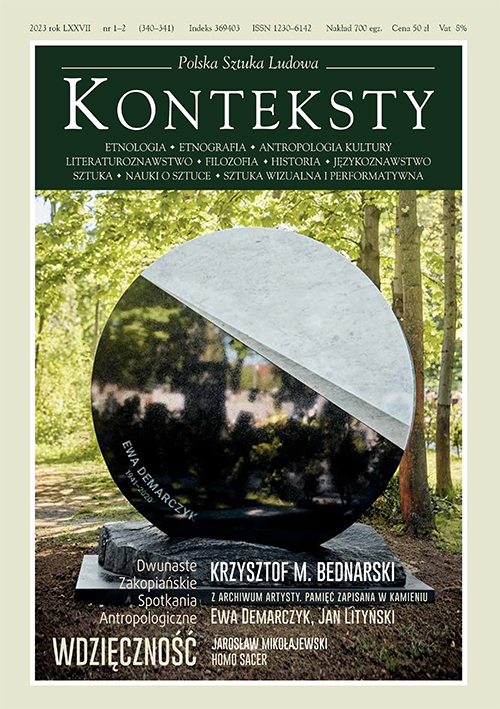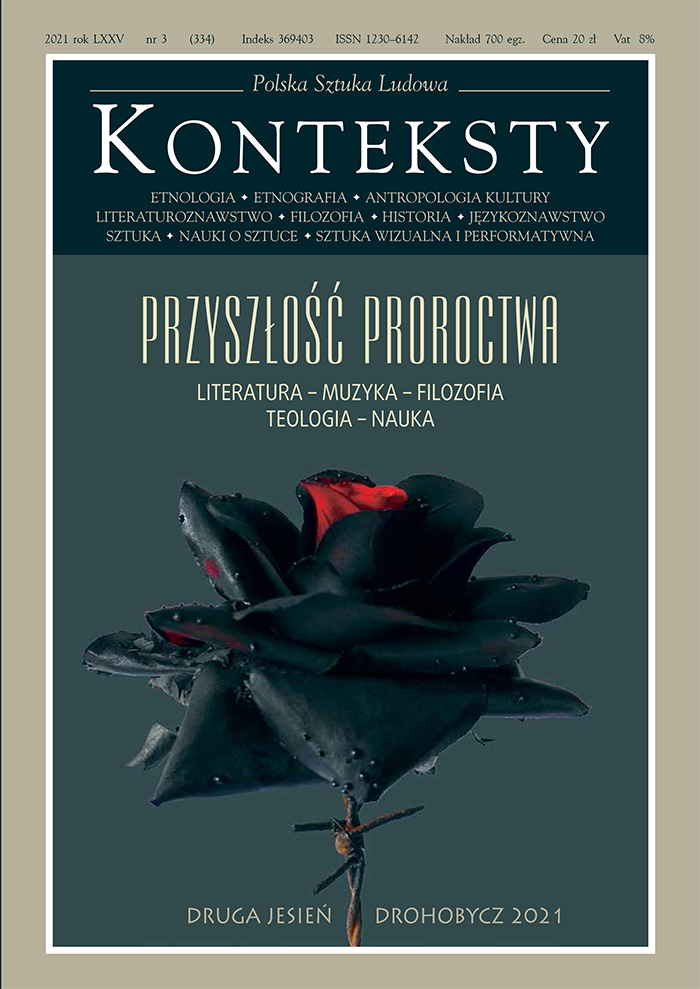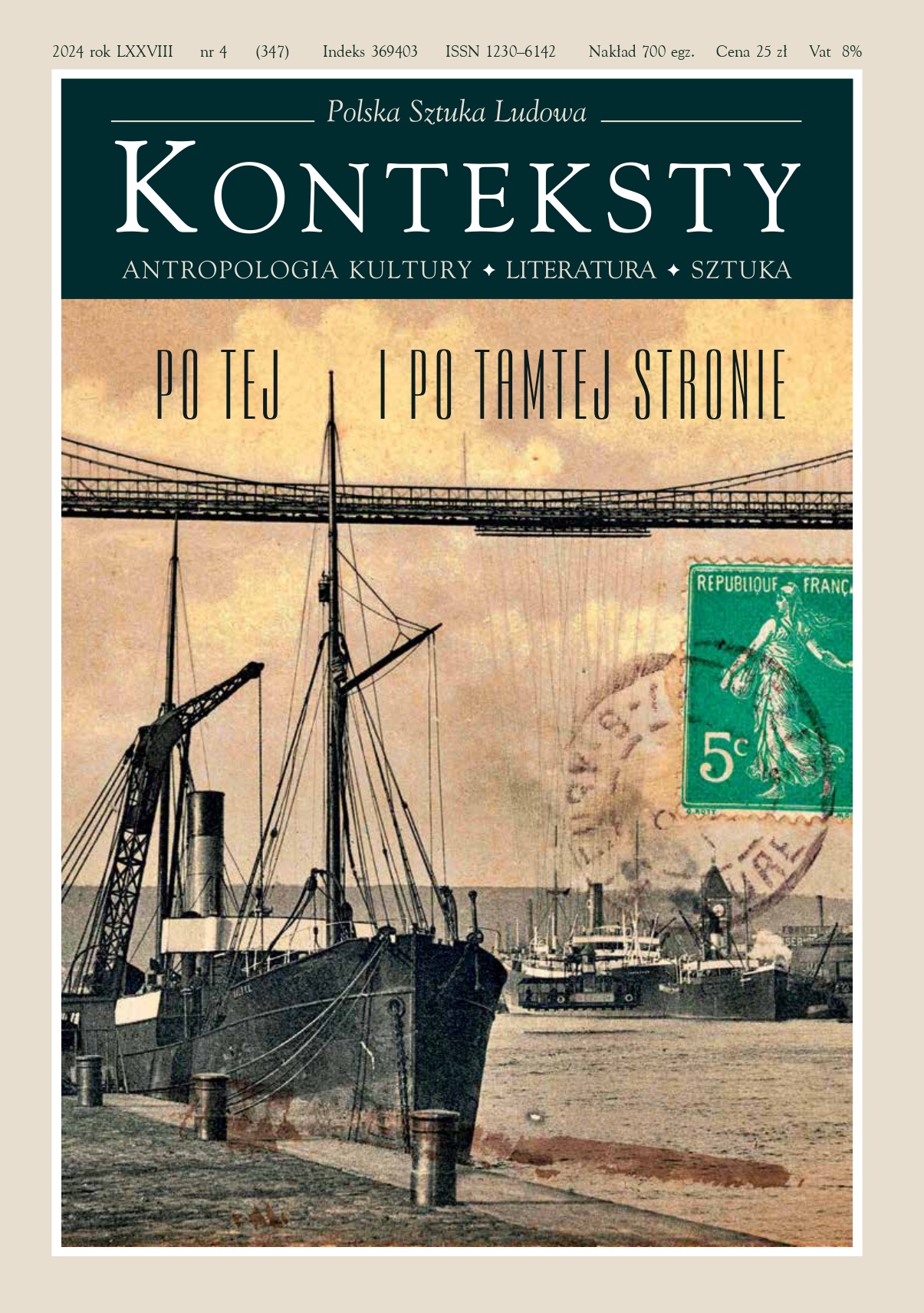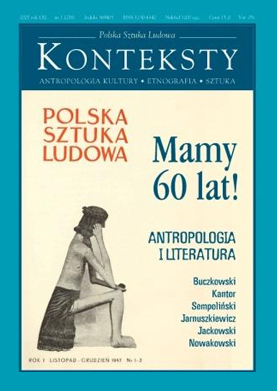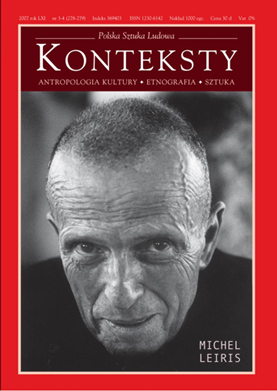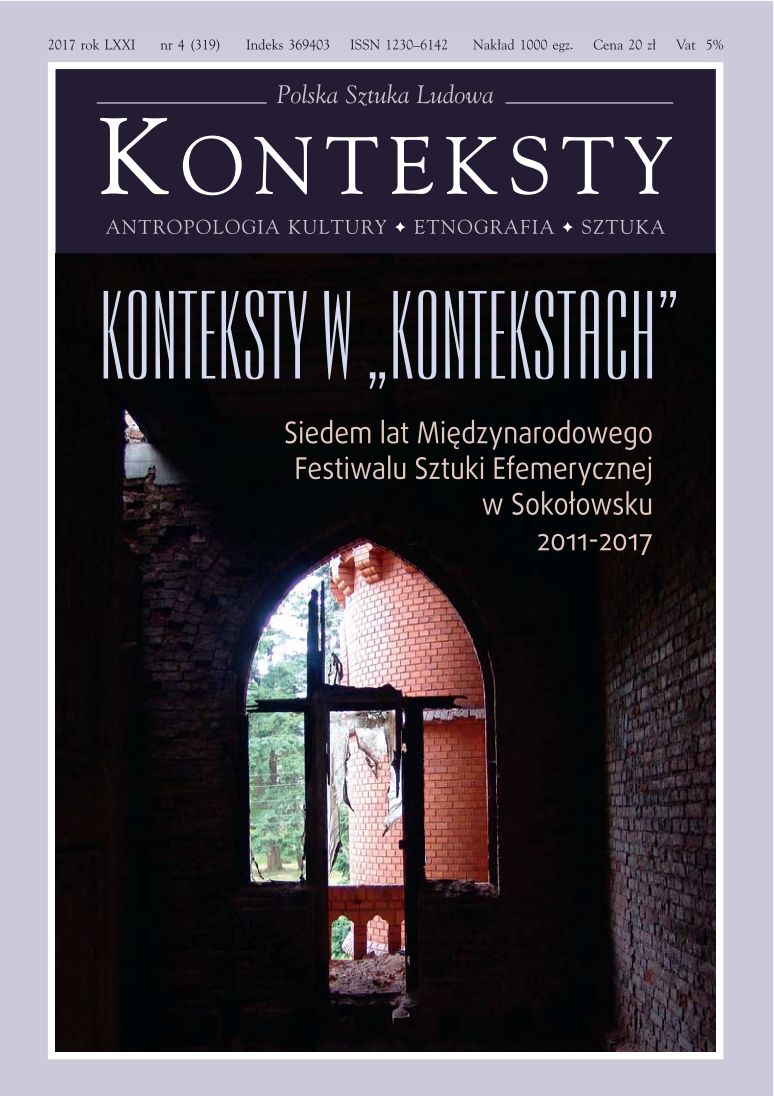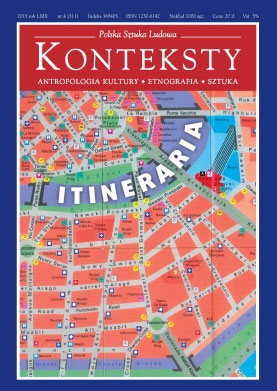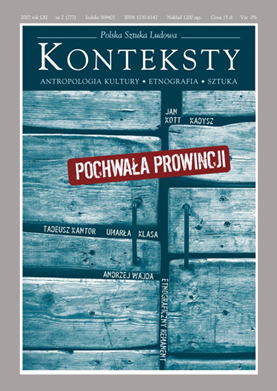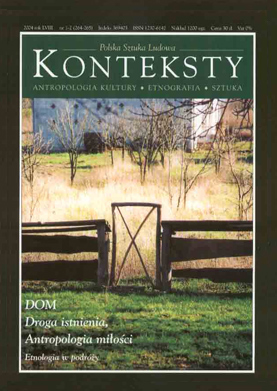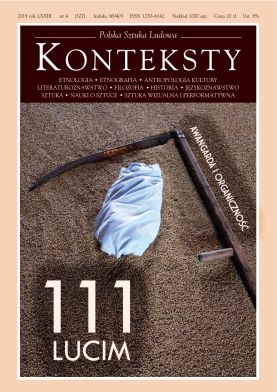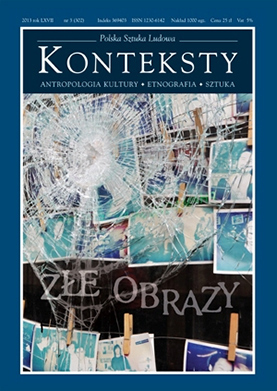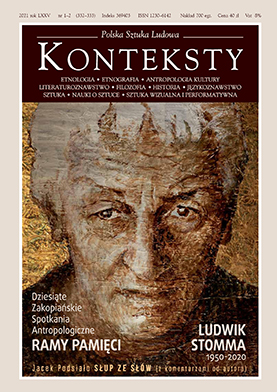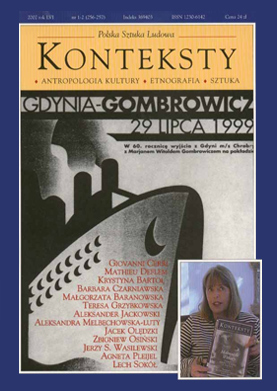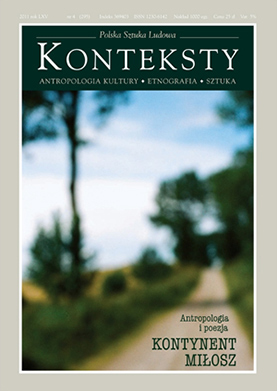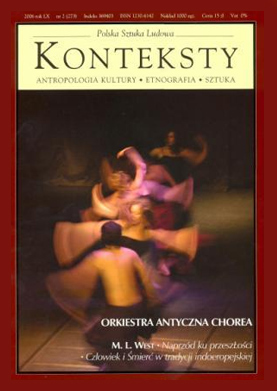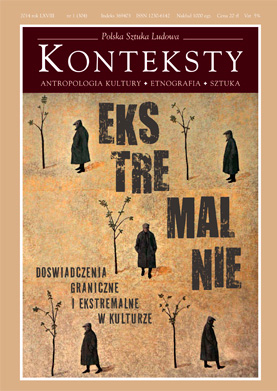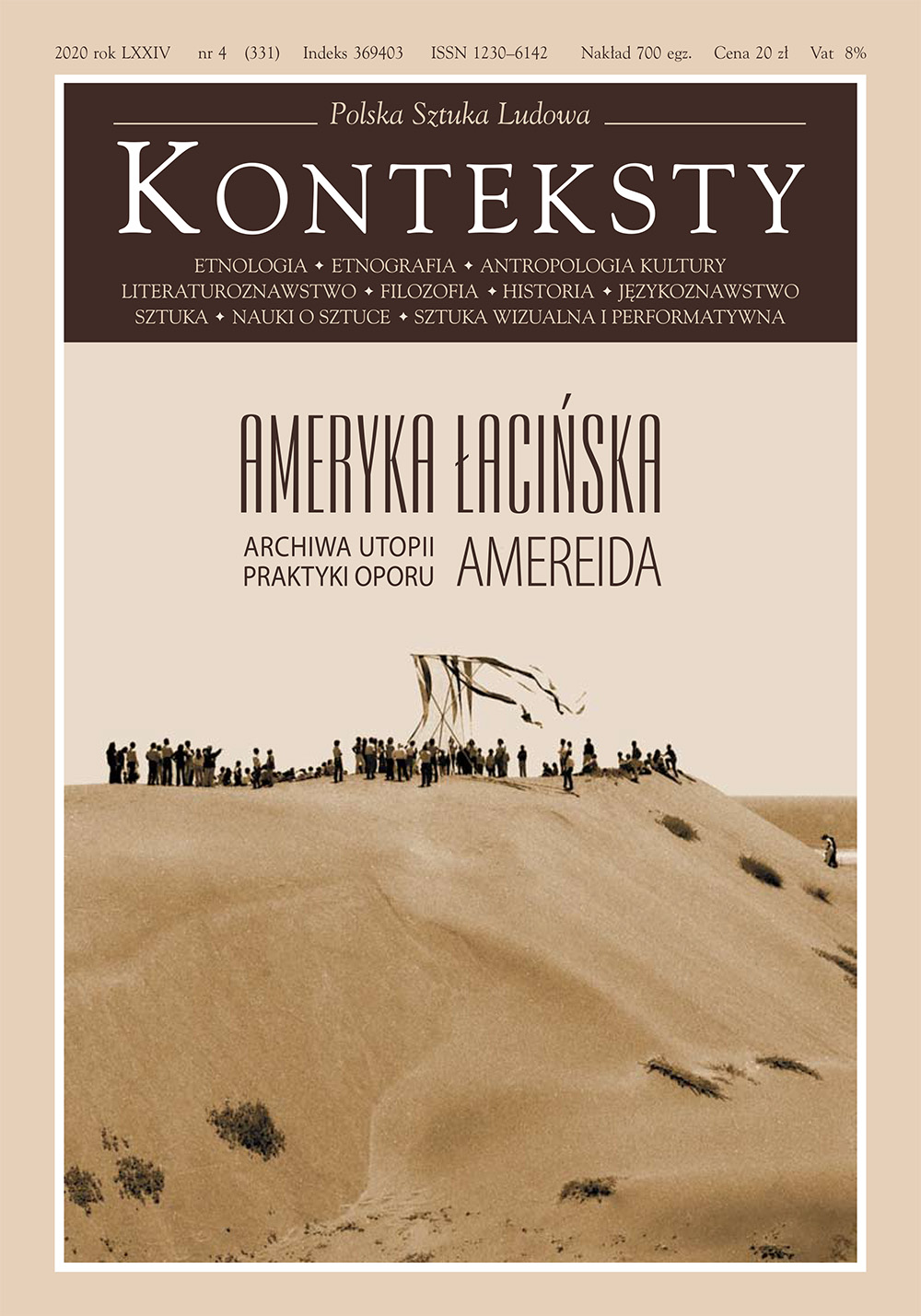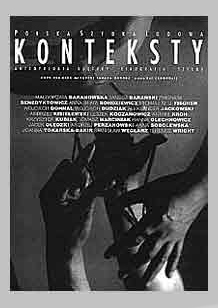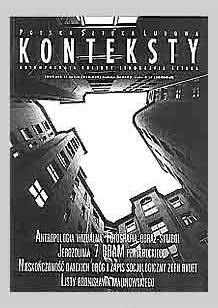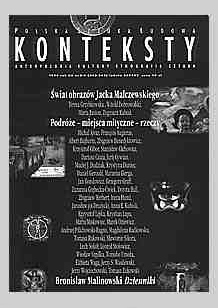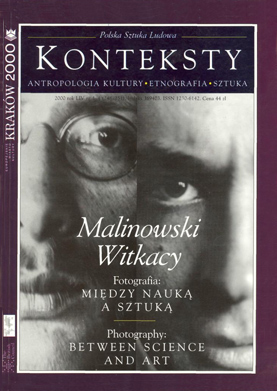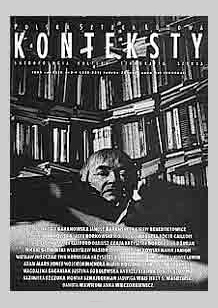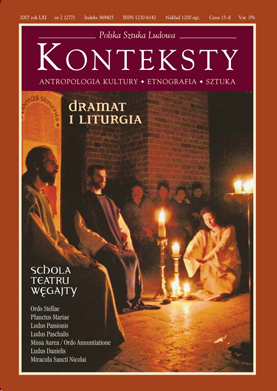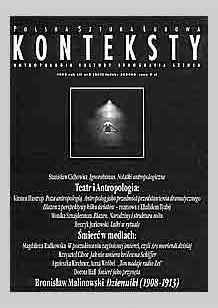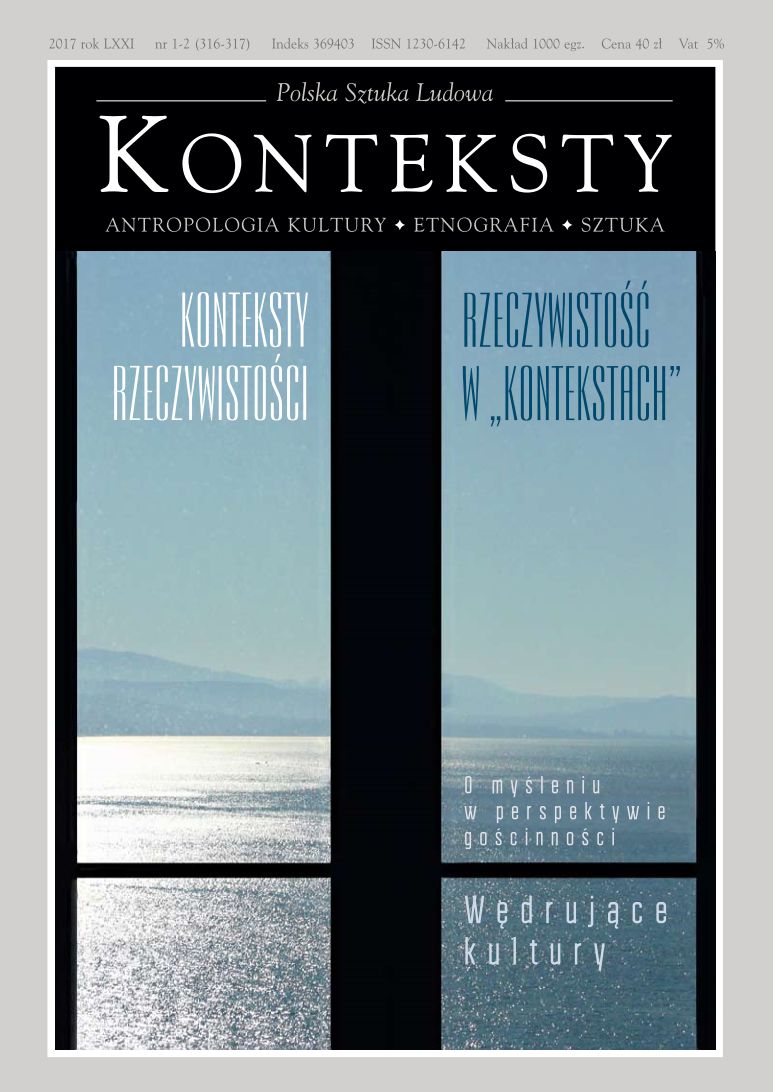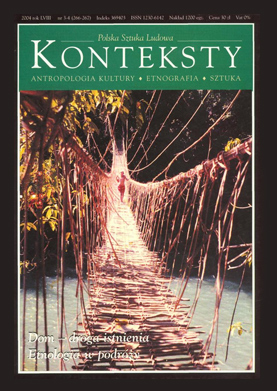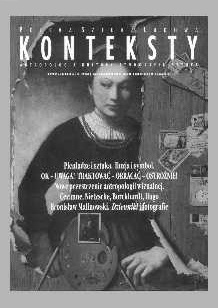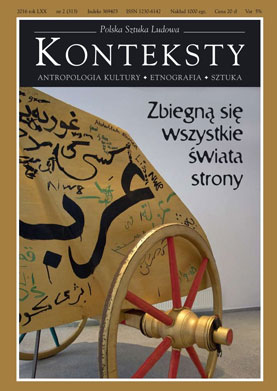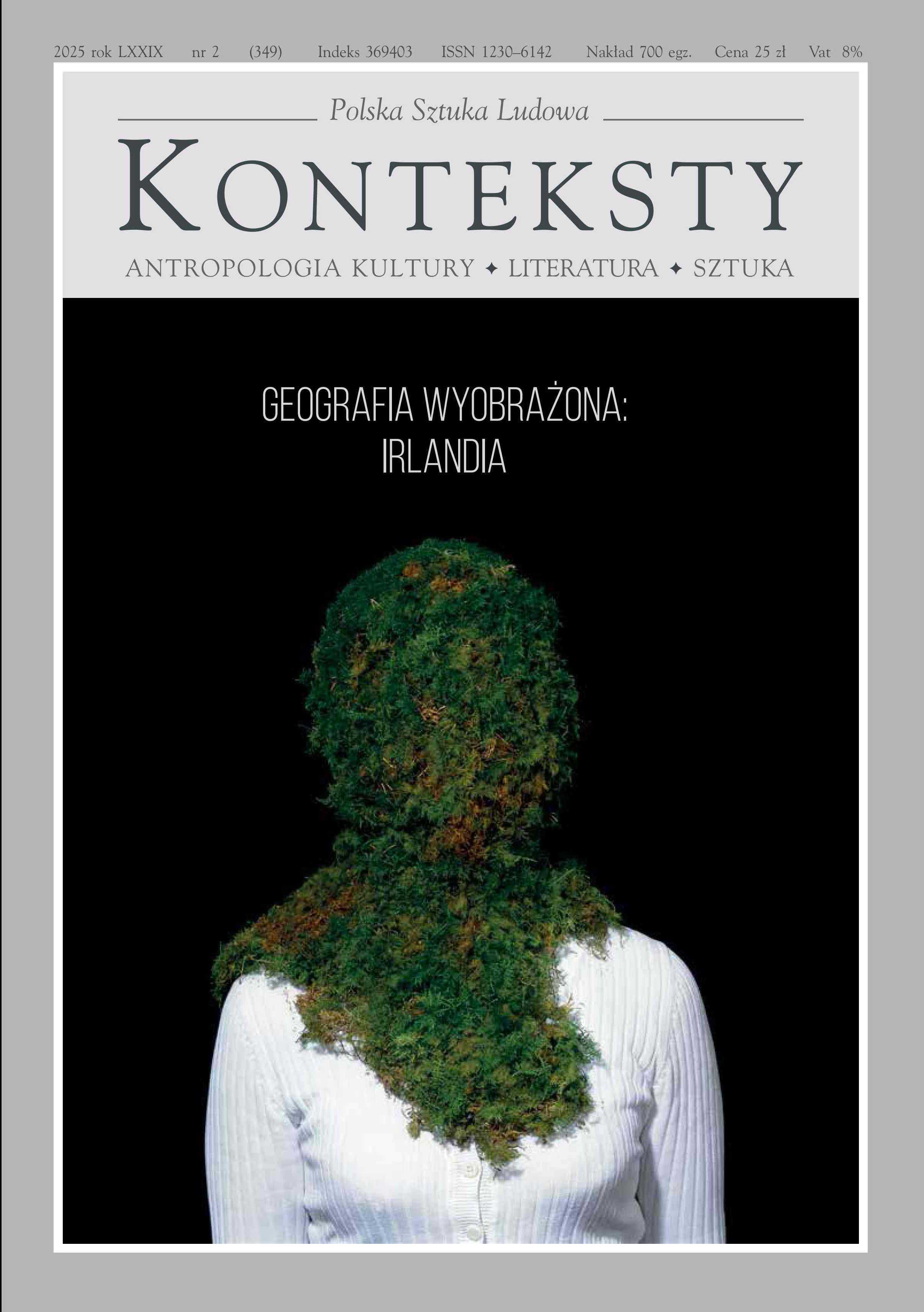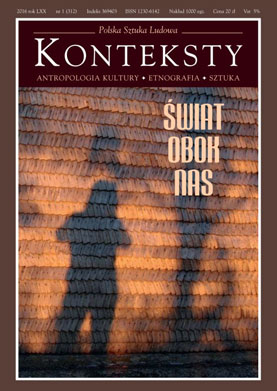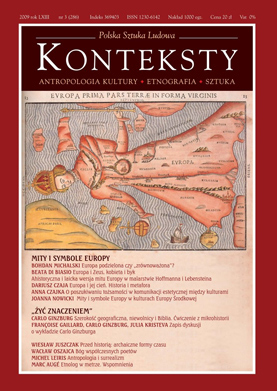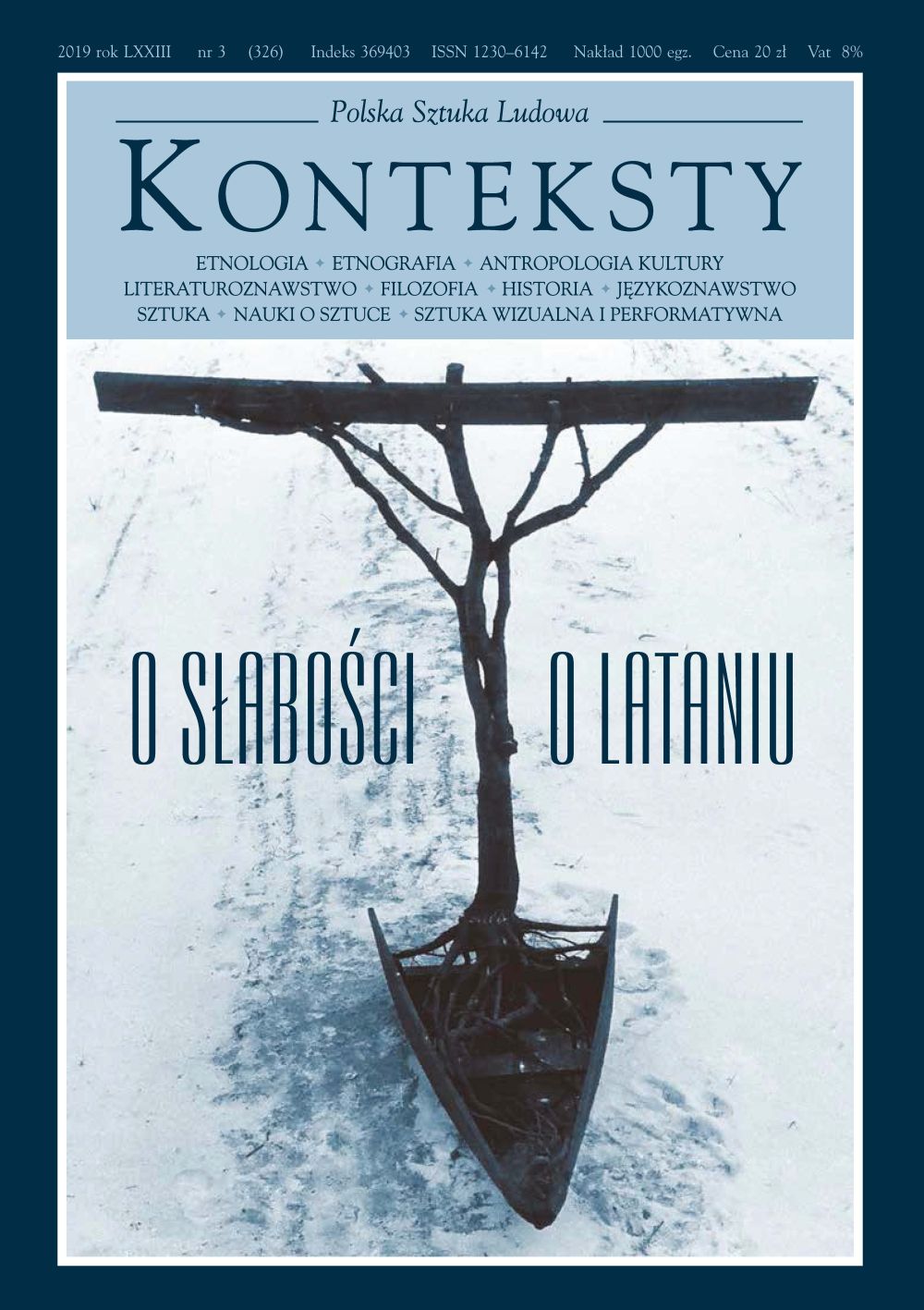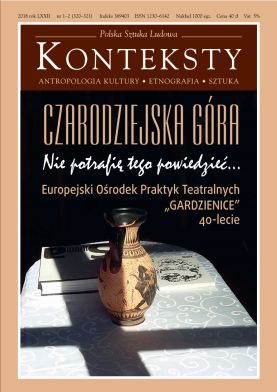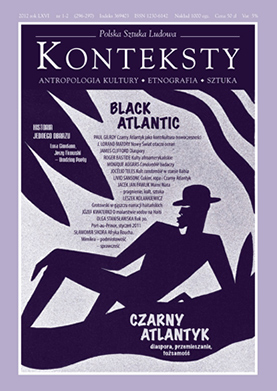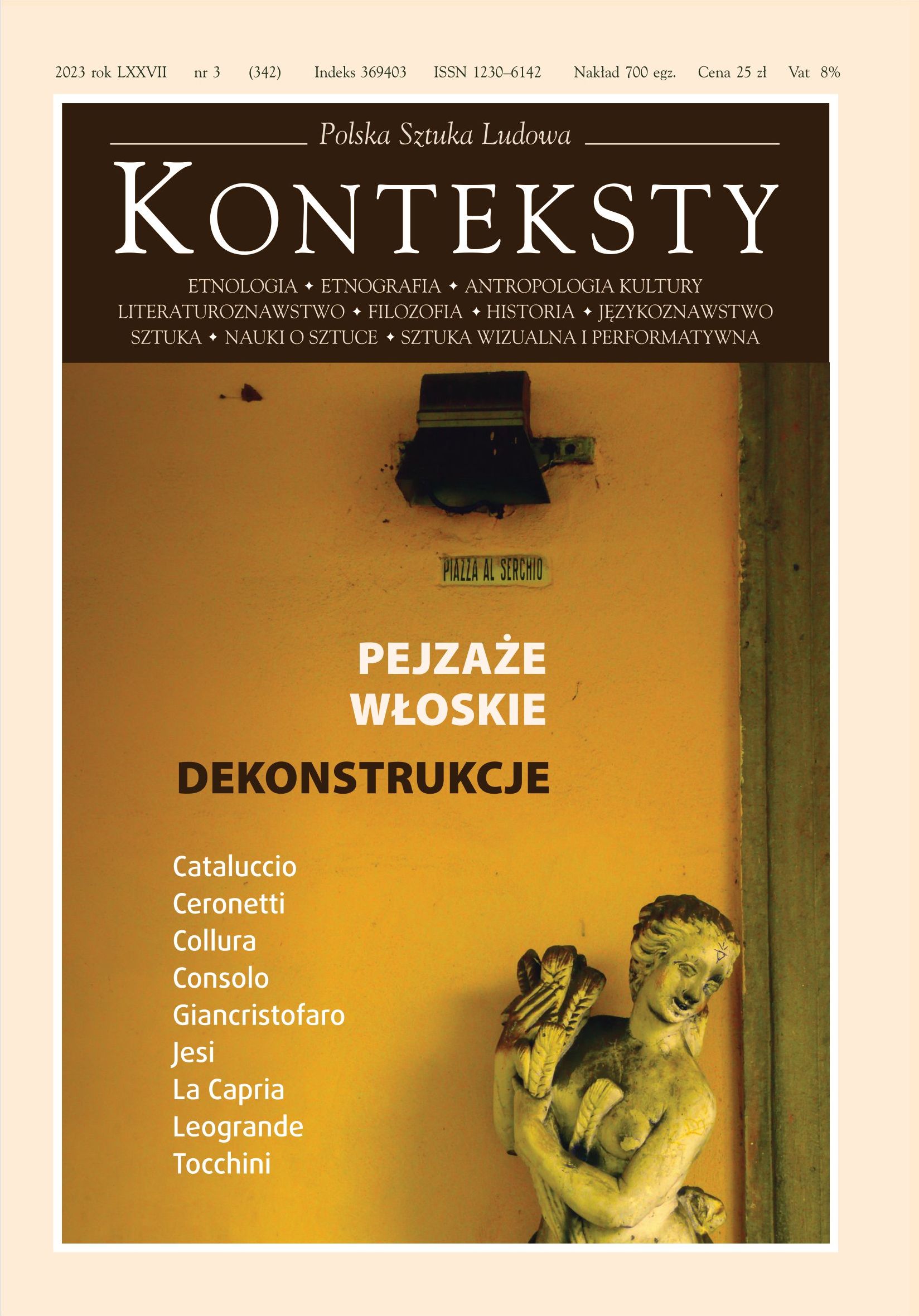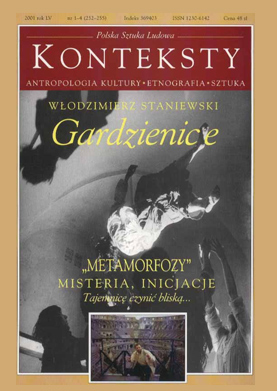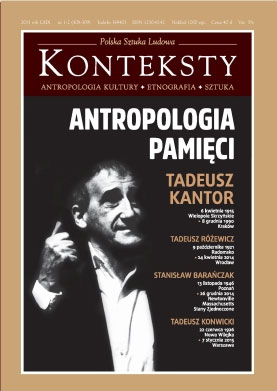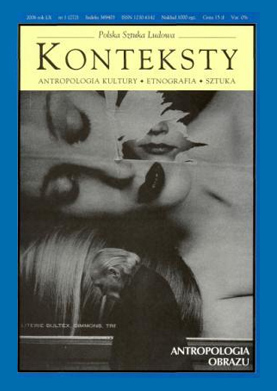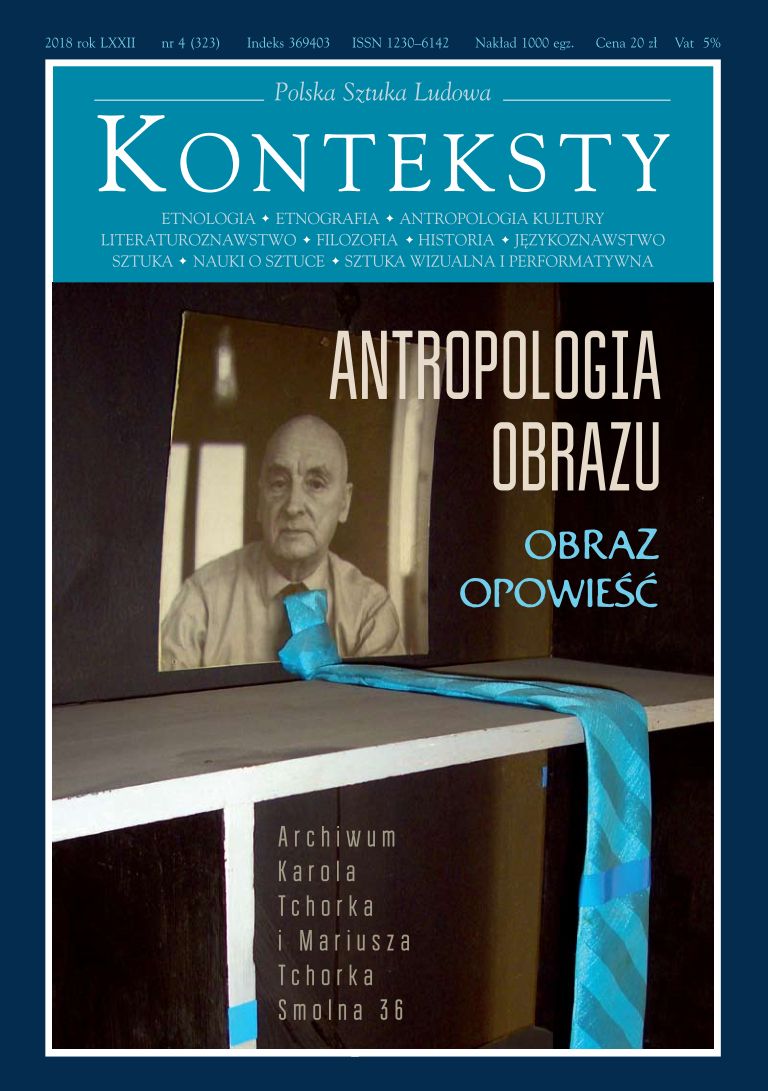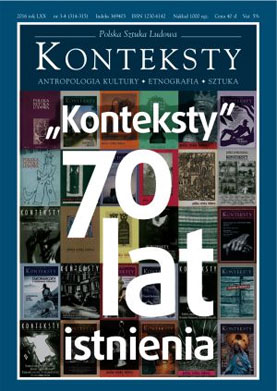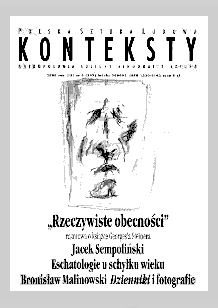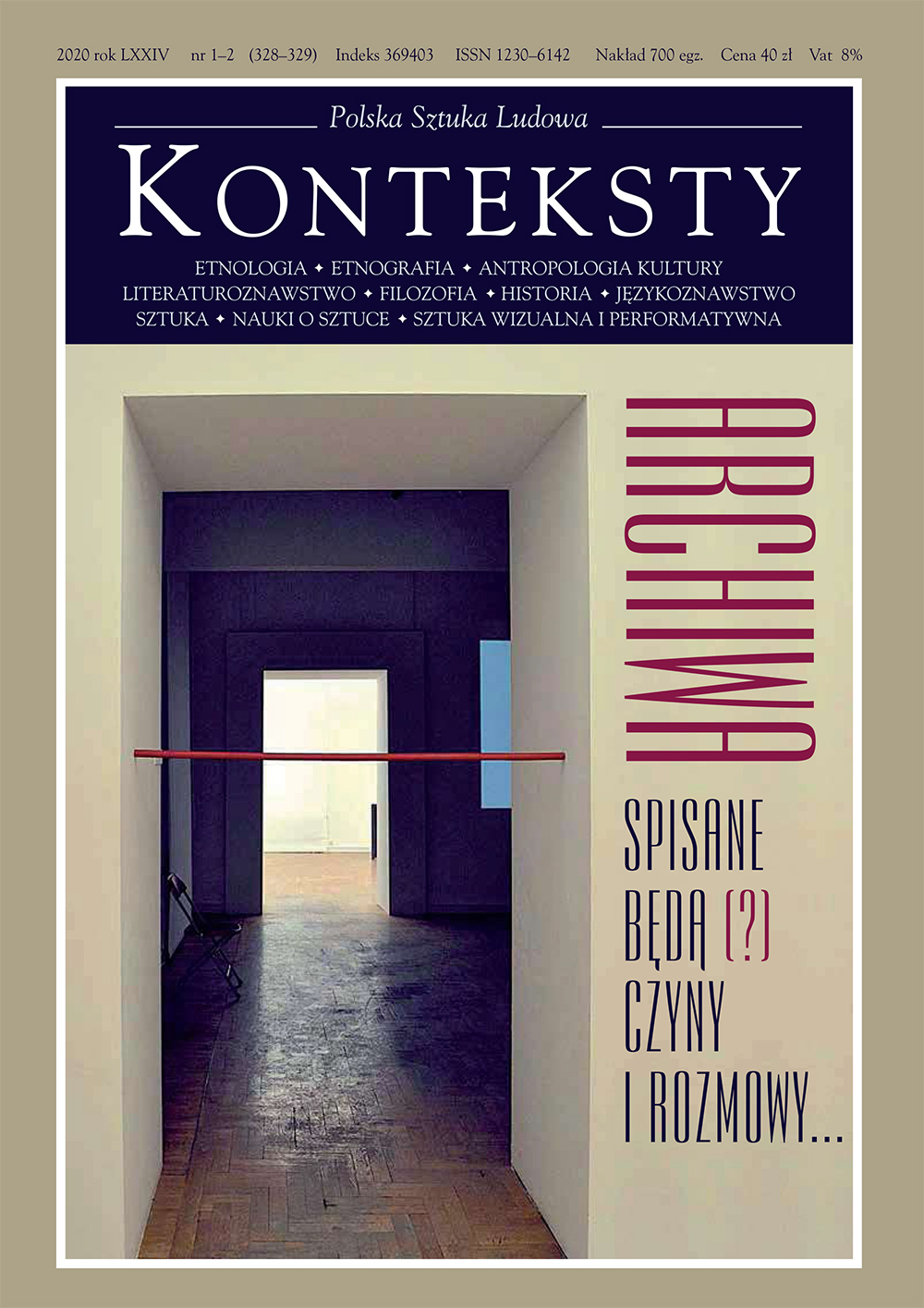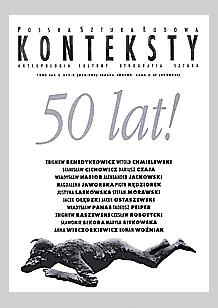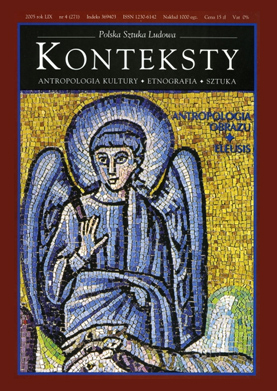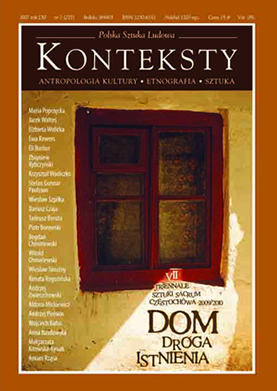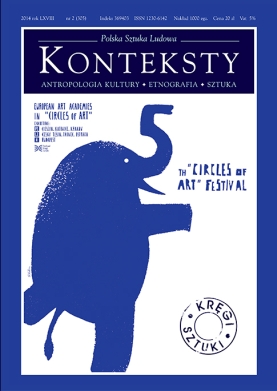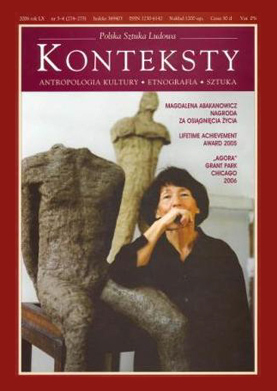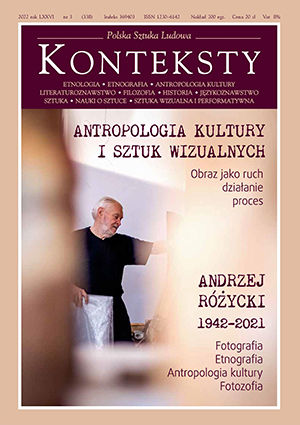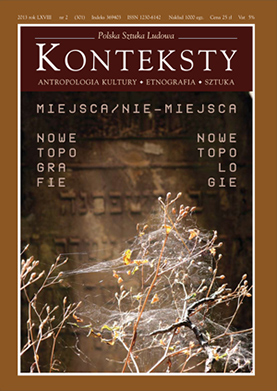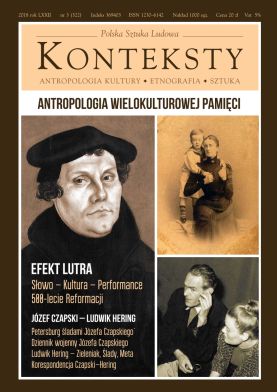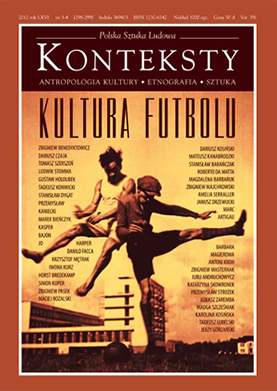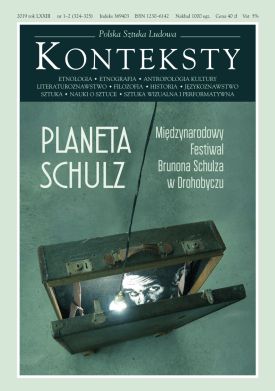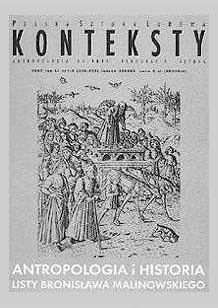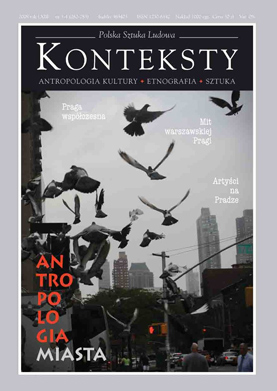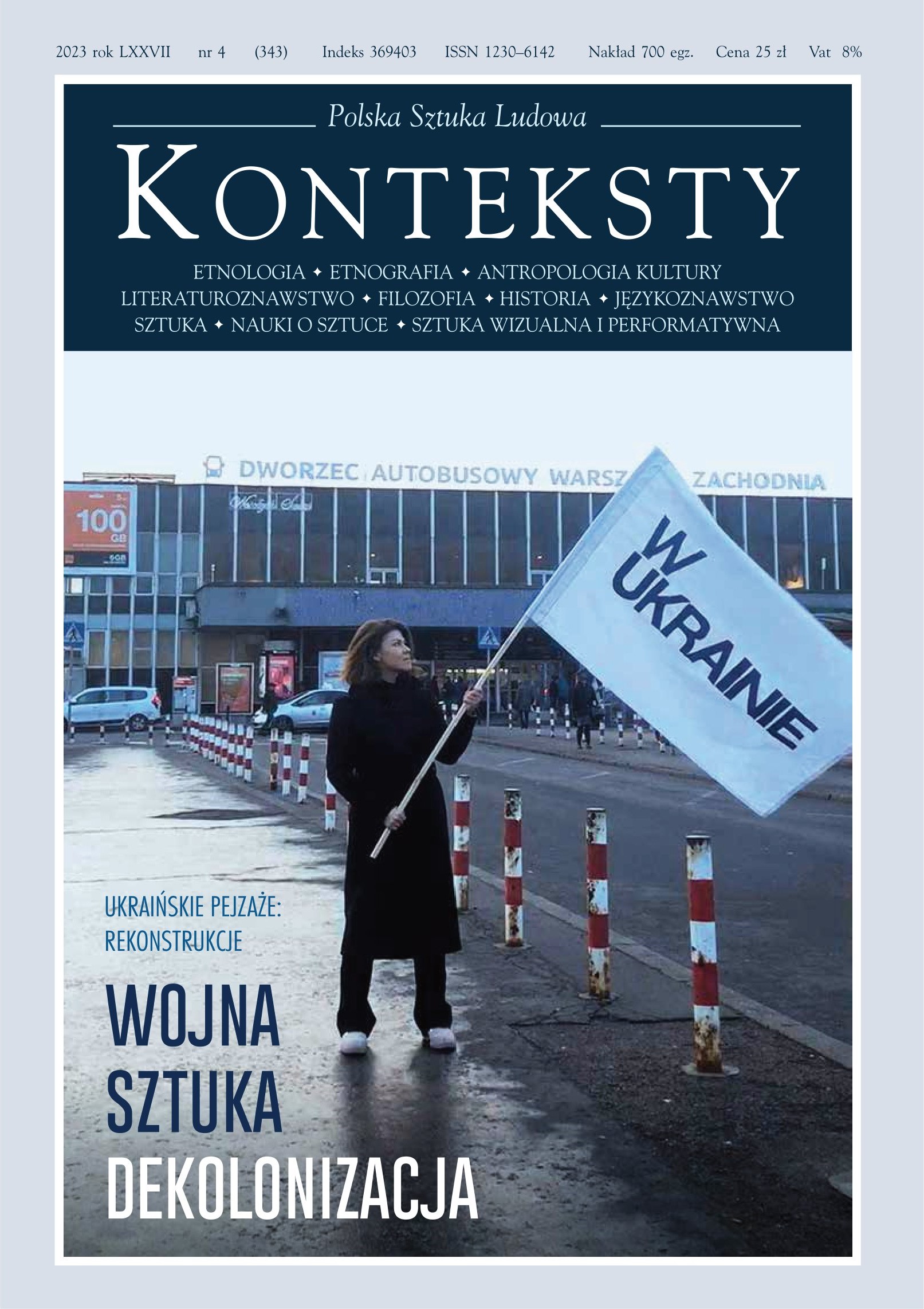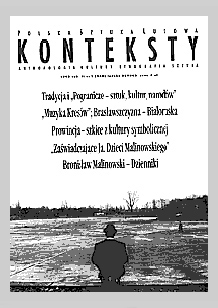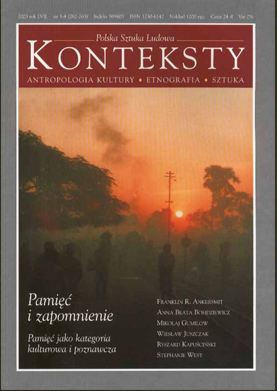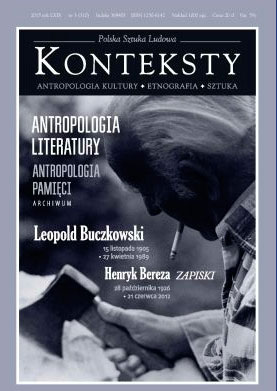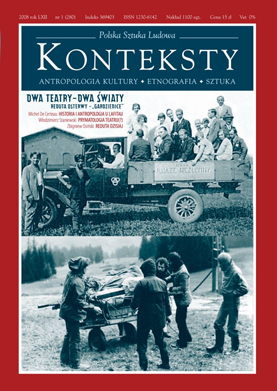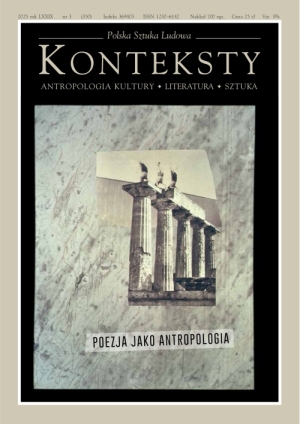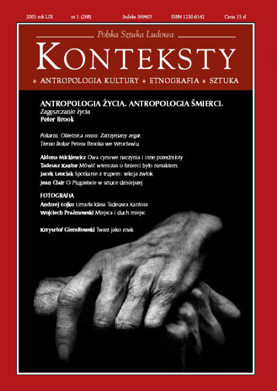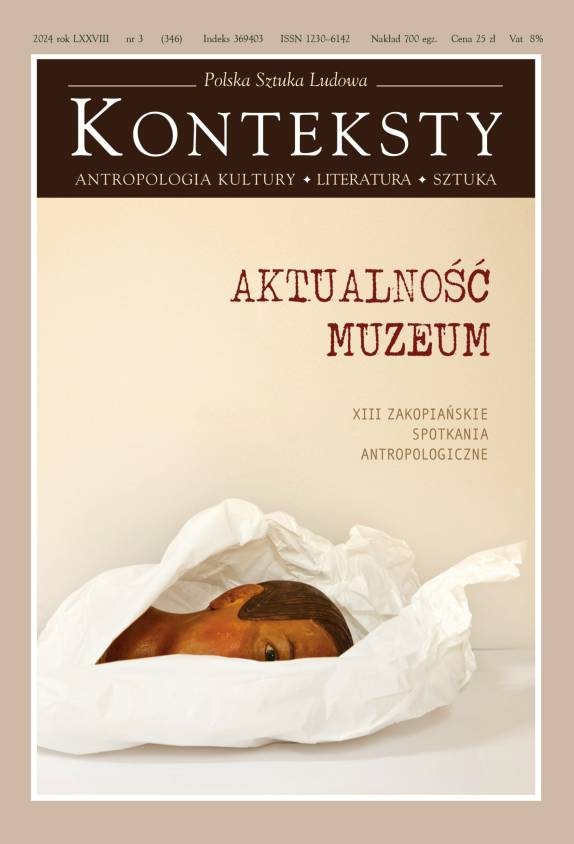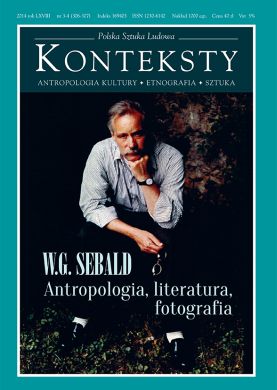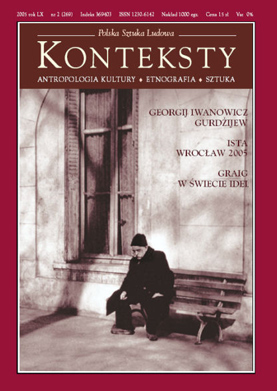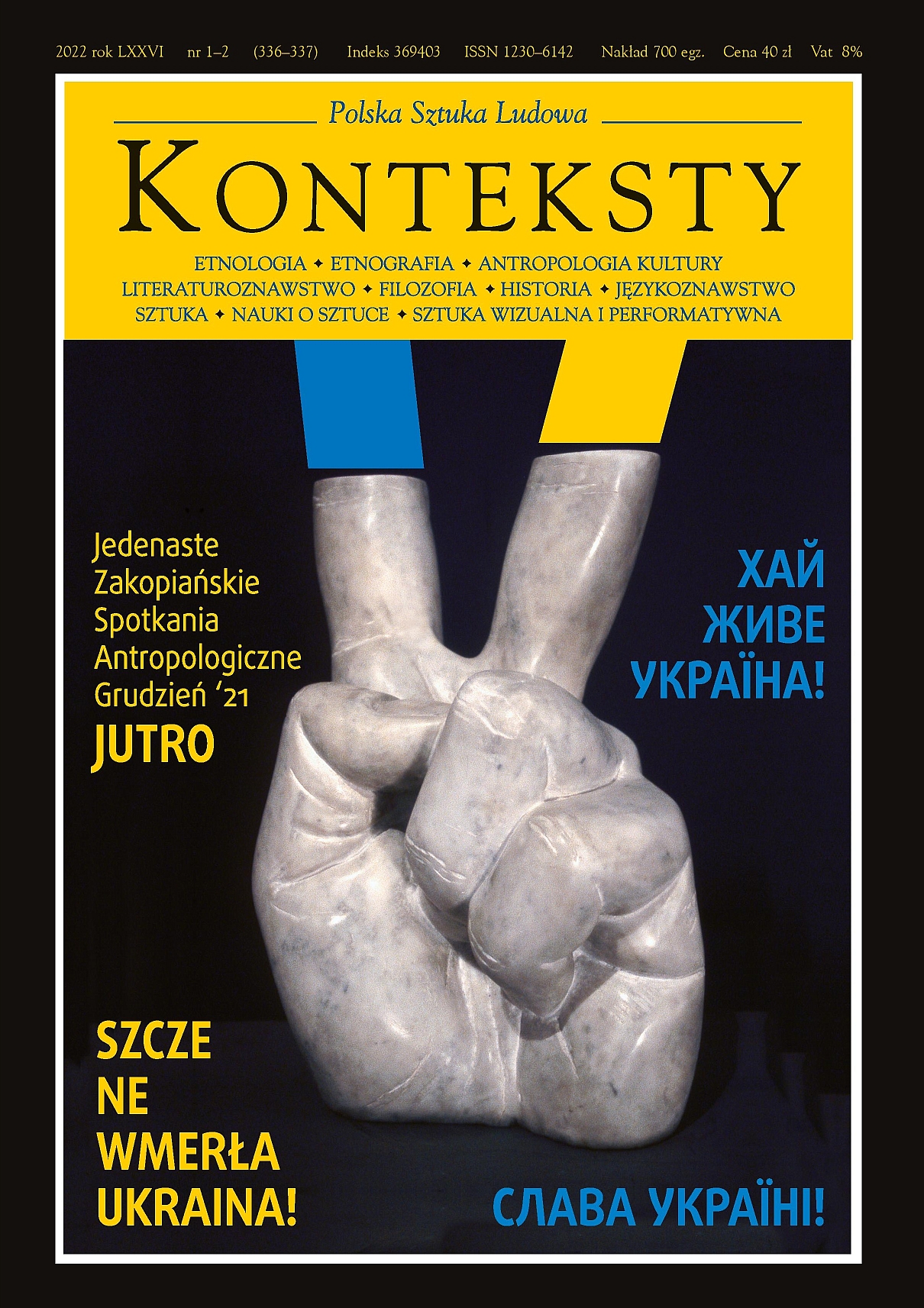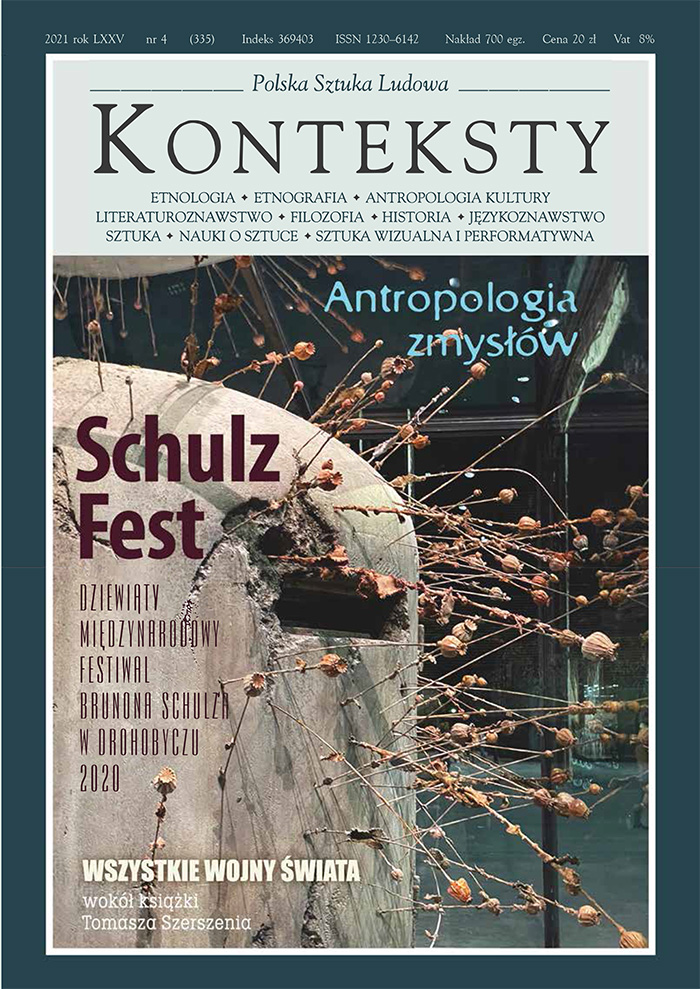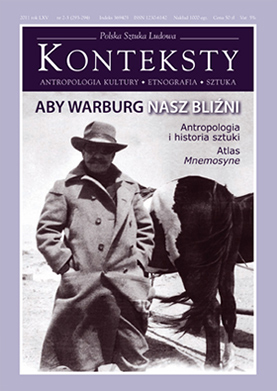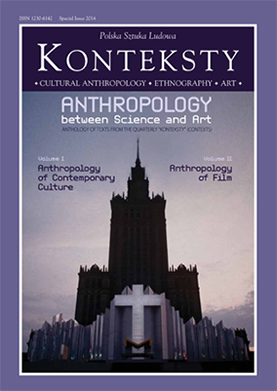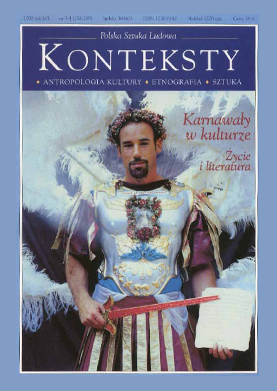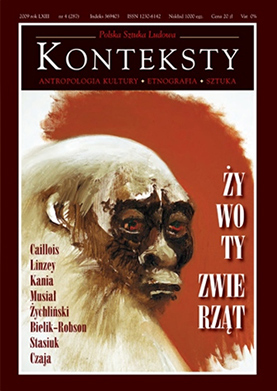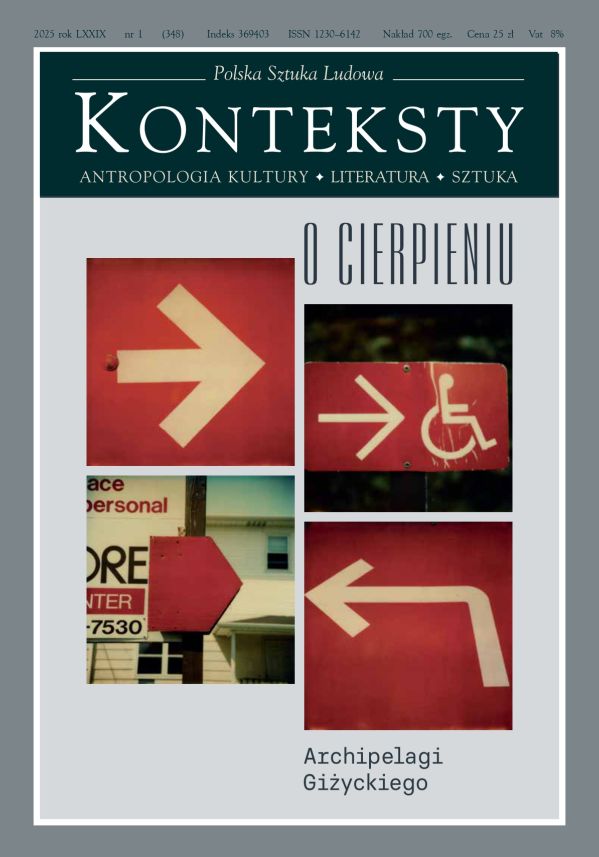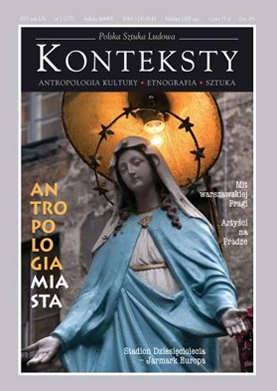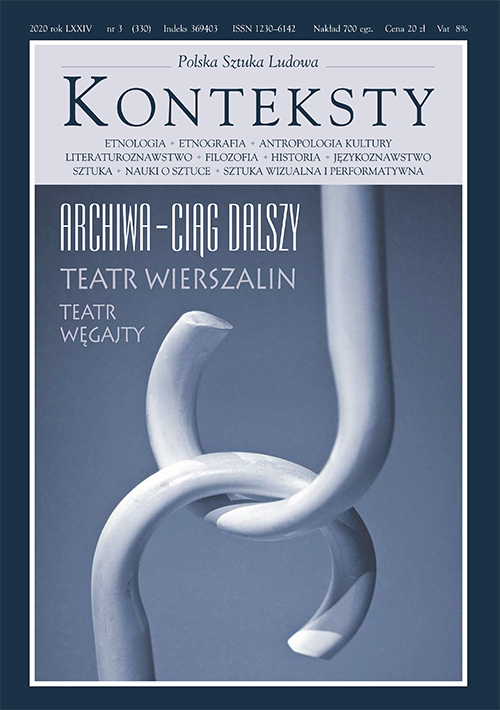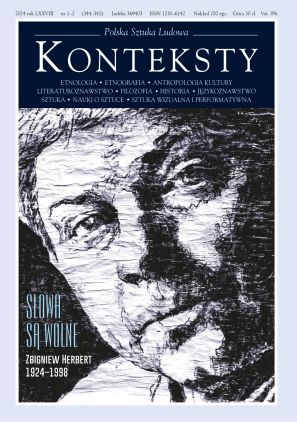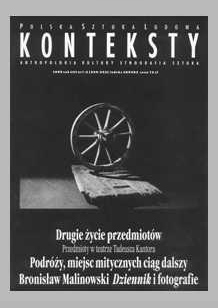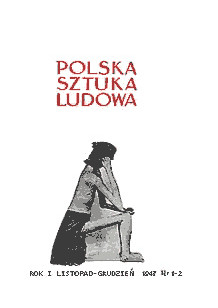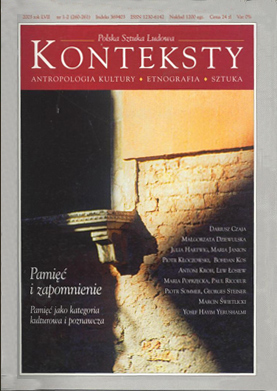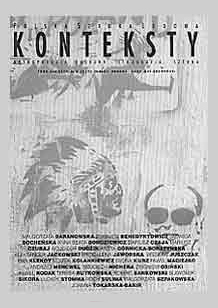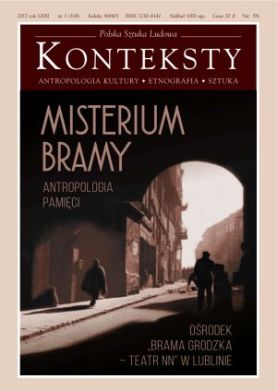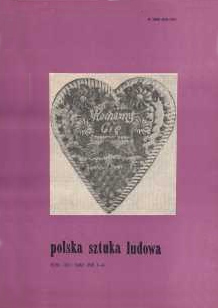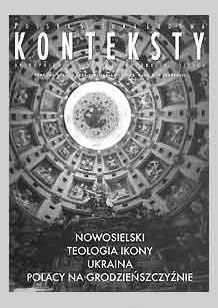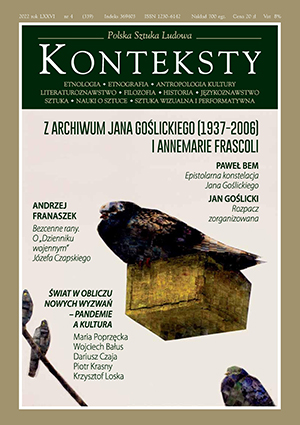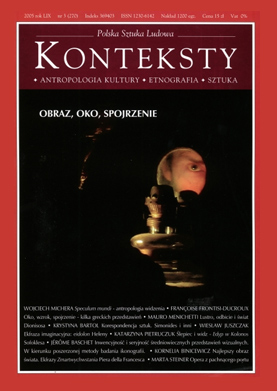Issue 2023/1-2 (340-341) - Gratitude / Schulzfest / Chodząc w Tatry
| XII Zakopane Anthropological Meetings – Gratitude | ||
| Zbigniew Benedyktowicz | Return to the Ithaca of gratitude | 5 |
| Kuba Szpilka | Gratitude or the spectral cat’s grin  | 11 |
An attempt at thinking the phenomenon of gratitude in the third decade of the 21st century. Working with tropes from anthropology, literature, and philosophy, it indicates that it is closely related to “weak presences” within the dominant order. To summon and render those presences visible opens a possibility for new being that multiplies existence’s potentialities. It is a gift that is perfect in its ephemerality, fragility, and finitude: it is gratitude without obligation — being always in the process of emergence, and being. | ||
| Janusz Bohdziewicz | On Gratitude and Thanks-giving  | 15 |
The theme of gratitude is topical and important owing to the fact that it goes against the tide of the widespread consumer, capitalist, legal, and subjective stand – it appears at the antipodes of the conviction that: “you make your own destiny”, “everyone is free and independent”, “everyone has an equal chance”, “nothing is for free”, and “quid pro quo”, and goes beyond “I must”, “I should”, “I want”, beyond will and conquest, but also beyond sacrifice and potlach. Generally speaking, this is a question asking whether there exists the possibility of selflessness, some sort of surplus in Nature and daily marketability, mercy in the world of politics and law – can gratitude be expressed and practised, what are its relations with memory, love, and “ordinary” recognition, what sort of placement in the face of ordinary dependences of being. | ||
| Janusz Bohdziewicz | Praise and Thanksgiving – on Thinking as Gratitude  | 17 |
The intention of this article is to outline the possibility of thinking conceived as thanksgiving – a task situated within the context of the current revolution associated with the dissemination of artificial intelligence (chatGPT). The essay derives this question from the writings of Martin Heidegger, possibly the first to associate thought with thanksgiving – and subsequently develops it within the context of works by the philosopher Jean-Luc Nancy, the pedagogue Jan Masschelein, and the anthropologist Tim Ingold. The presented thesis consists of a conviction that grateful thinking opposes metaphysical thought, traditionally conceived sciences, and knowledge – and stems from a cautious, non-intentional opening to the given world. From that time it is not solicitous cognition and certitude that are the targets of thinking, but its source is acceptance of unpredictable events in their praise and thanksgiving via adoration. Thinking conceived as gratitude is an affirmation of the inalienable essence of humanity, and its shaping is hope for the ability to live while facing uncertain times. | ||
| Agnieszka Giszterowicz | The Capital of Gratitude. Gratitude within the “Wn-Ma”. Configuration. Gratitude as an Economic Category  | 25 |
The author embarked upon an attempt at interpreting gratitude within an accounting entry and wishes to present thanksgiving as an object of an economic account. Her goal is to answer the question: are wages capable of expressing gratitude? When do they become remuneration? And is gratitude an economic category? The theoretical foundation of reflections and the formulation of hypotheses constitutes the scientific theory of capital and the model of human capital devised upon its basis. | ||
| Tadeusz Bartoś | Dimensions of Gratitude  | 32 |
In the world in which we live, gratitude is increasingly becoming an obligation, an element of the exchange of goods. Its essential characteristic of spontaneity is being lost. In the Christian world, gratitude is an expression of one’s relationship to the benefactor – God. In Christian creationism, everything that man possesses is a gift, both his existence and his ability to do good (grace). The deprivation of the autonomy of the value of the human individual in Christian anthropology burdens man with the duty of total gratitude: having nothing himself but receiving everything as a gift. In the era before the dominance of monotheisms, i.e. in ancient Greek times, gratitude, according to Friedrich Nietzsche, was a fundamental attitude towards the world. It was forgotten and lost when the mob came to the fore. | ||
| Michał Klinger | Ungrateful Gratitude. Gratitude as a Successive Elemental Phenomenon of the Anthroposphere  | 37 |
Starting with inspirations shared with Zbigniew Benedyktowicz, the problem of gratitude will be addressed as either morally or religiously conditioned, or rather “ungrateful” – i.e. freed from all axiology. The analysis of cases known in culture reveals gratitude as a miracle, a revolt in the field of religion and the Anthropos sphere, at the same time as an “element” from a group embracing both salvation and joy. | ||
| Stanisław Krajewski | Gratitude  | 43 |
Feeling of gratitude is good for interhuman relations. A culture of gratitude can be justified by some interpretations of the Torah. What is more, perhaps our ability to feel gratitude is one of those characteristics that define our humanity. For it seems especially hard for computer simulation. Expressing gratitude constitutes the most fundamental form of prayer. This is for sure true in Judaism. According to Christian monk David Steindl-Rast gratitude is the heart of prayer. What is more, occasionally, for a moment, it can become a total, overwhelming experience. If so, then a dimension opens that can be understood as theological. | ||
| Wiera Meniok | “Time to Say Thanks and Move On”… Serhiy Zhadan’s Crossroads of Gratitude  | 47 |
Time to shut gates and windows. – Time to reminisce. – Time to foresee. – Time to feel “the damp smoke of departure”. – Time to share the remains of bread. – Time to move on. – Time to say thank you to: the brightness of hills, birds in attics, those holding doors while the dead are being carried out, visitors of the ill in empty houses. – Time to appreciate the potential of language. – Time to recall rhymes. – Time to speak and time to die. – Time of singing. – Voice of anger. – Voice of gratitude. The author of this article listens to the crossroads of gratitude in the poetic voice of Serhiy Zhadan. And in his war chronicle: “The only thing that remains unaltered is our memory. And our gratitude”. The voice of Serhiy Zhadan is one of the most recognisable voices of Ukraine at war. It does not vanish even when the poet seeks words and is incapable of regaining them so as to return to writing poetry. After 24 February 2022 he was for a longer time unable to write a single word, maintaining that words no longer came to him and although he is certain that the voice of his poetry will change he does not know how it will do so. On the other hand, his voice never abandoned him. Then words returned. The first poem – Perhaps now it is worth starting… – was written on 15 June 2022. Zhadan thus began as if from the very beginning and his voice regained words. A new poem appeared on 4 June 2023: “Perhaps now it is worth speaking […] / And there is no silence – / Only our fear to speak …”. A year separated the verses: “Perhaps now it is worth starting…” and “Perhaps now it is worth speaking…”. And there is no distance between them. Serhiy Zhadan is beginning to speak and does so despite the war. The voice of his poems does not become that of hatred. It remains the voice of gratitude. Also gratitude for the worlds of Schulz, which do not cause trauma. And for those whom he happened to meet in the night-time streets of Drohobych and whom he now recognises by the way they walk and breathe. A simple humane: “Thank you for your love, dear brothers and sisters!”. | ||
| Paweł Próchniak | Silent Clouds, Dreams. About the Poetry of Ryszard Krynicki  | 61 |
The essay concerns the poetry of Ryszard Krynicki and discusses its main features and threads; at the same time it is an act of gratitude inserted into interpretive passages – gratitude to the poems, but also to their author, Ryszard Krynicki. | ||
| Dariusz Czaja | Expressions of Gratitude. In Memoriam Pavel Muratov  | 63 |
Images of Italy – a book by the Russian historian of art Pavel Muratov, published over a hundred years ago, is a legendary work both known and unknown. Regarded from the very onset as a masterpiece mainly among the Russian-speaking public, Muratov’s book remained unfamiliar to the European reader for 60 years. Not much was altered by translations into the Polish and the most recent translation into Italian. Despite relatively slight popularity Images of Italy enjoys a high rank amongst humanist readers. The author follows the sources of admiration and the perennial cognitive and literary merit of this enthralling publication. | ||
| Tomasz Wiśniewski | Applause, Ovations, Flowers, or Steiner’s Restitution in the Theatre  | 71 |
In this article reactions of audience are taken into consideration in view of a hermeneutic process that characterises theatre semiosis. Research material covers four performances, i.e. 1989 (dir. Katarzyna Szyngiera, Gdańsk Shakespeare Theatre and Teatr im. Juliusza Słowackiego in Cracow), Once Before I Go (dir. Selina Cartmell, The Gate Theatre in Dublin), Tosca (dir. Ognian Draganoff, The National Opera in Iasi) and Drive Your Plough Over the Bones of the Dead (dir. Simon McBurney, Complicité). The study is of a comparative character and discusses a spectrum of possible functions ascribed to audiences’ reactions. | ||
| Katarzyna Kręglewska | The Theatre and War. On Practising Gratitude  | 80 |
The text is dedicated to forms of the presence in Poland of Ukrainian theatrical authors and Ukrainian culture after 24 February 2022. An analysis of ways in which representatives of theatrical milieus reacted to the situation of the catastrophe and changes that occurred within the domain of Ukrainian and Polish theatrical life, as well as their connection with events within social space. The domain of theatrical activity is treated as a sui generis sphere of contact, i.e. space for meeting the Other, based on mutuality and perceived in reference to questions of cultural mobility. A survey of select theatrical events (which took place predominantly in the Gdańsk, Gdynia, Sopot Tri-Ci-ty) constitutes a point of departure for reflections on the role of practising gratitude in the process of constituting a community. | ||
| Monika Krajewska | Thanking for the Spirit and Lightning  | 93 |
In Jewish Shabbat, holiday, and daily liturgy “thank you” and “may you be blessed” appear next to each other and essentially express the same. Gratitude, blessing, and adoration are articulated in one breath. Blessings praise the Creator for the origin of the world together with all its elements, from the cosmos to the slightest plant. Even mundane details deserve to be appreciated. Here is my favourite example from a morning prayer: “Blessed […] who gives the rooster understanding to distinguish between day and night”. Just like in Grajmy Panu (Let Us Play for the Lord), a song by Agnieszka Osiecka: “Oh, You, who is watching the poor houses of snails / and the great mountains of both Americas […] Thank You for giving us the time”. Words foreseen by the ritual are reflected in ritual art: the decoration of objects made of silver, fabrics, verses painted on the walls and vault of synagogues. I follow this trail in my cut-out collages inspired by the heritage of the old Jewish cut-out and more widely – by visual tradition, in which the word and the image merge and intertwine, and the letter is used as plastic arts matter. This phenomenon is illustrated by presented works containing thanksgiving blessings alive in liturgy. | ||
| Paweł Drabarczyk | Shining. Looking at Our Reflections in ‘Kryjówki. Architektura przetrwania’ by Natalia Romik  | 99 |
Nine irregularly shaped and silver-plated casts. Nine three-dimensional maps copying territories of survival – Hiding Places created and inhabited by Jews at the time of the Holocaust, i.a. inside an oak tree trunk, underneath a floor, inside sewers, in a grave. “Sculptures are homage to the architects and engineers who created them” – said Natalia Romik about metal objects on display at the Zachęta National Gallery of Art, accompanying an exhibition presenting the results of interdisciplinary studies on the Holocaust “architecture of survival”. Its non-visual character (a hideout protects against a stalking gaze, an “evil eye”) found in the exhibition a controversial reverse, with the ostentatious, idolatrous glistening of the surfaces of these anti-monuments commemorating those hiding themselves and those who hide them. Silver “resembles mercury, a mirror. It reflects but also deforms” (Romik). Quite possibly similarly to the way our gratitude is deformed, more interested in its own image than in that which is concealed beneath the glistening surface. What do Kryjówki conceal from us and what do they disclose? | ||
| Monika Sznajderman | House of Eternity, House of Gratitude  | 105 |
This text is dedicated to the Jewish cemetery in Gorlice – a sub-Carpathian town up to the Second World War inhabited by more than 3 000 Jews, male and female, i.e. slightly over 50 percent of the entire population. The cemetery contains only an ohel and several matzevahs, but it is difficult to decipher anything featured on them. Memory too is defunct in spite of the fact that thousands were buried here – the cemetery is already over 200 years old. Nonetheless, life goes on and that which once was human is now intertwined and becomes a unity with plants and, more extensively, with Nature. The cemetery is overgrown by old trees and shrubs; stones crumble and establish symbiosis with plants covering them; deer graze in high grass. Ewa Domańska wrote in Nekros: a cemetery is “a terrain of widely comprehended heritage, transgressing the ideas of culture and Nature, a chronological line of short time; a place where time unravels and assorted entangled histories, to use a term devised by quantum physicists, function, and where various chemical and physical processes turn into processes creating the sphere of the sacrum”. The author of the article is interested precisely in those “entangled histories” and crumbling space, which initiate a joint – botanical-anthropological – story about the Jews of Gorlice, their life and death, the traces they left behind, and the new form of existence whose part they are. “Woven into / eternal being – / you shall not elapse, / not elapse” – the poetess wrote. | ||
| Łukasz Stypuła | The Sacrifice of Thanksgiving  | 117 |
The author chose as the point of departure for his reflections on the meaning of the sacrifice of thanksgiving in the Old Testament ritual thanksgiving psalms, recognised usually by the presence of words originating from the Hebrew jada – give thanks. Such phrases as hodu – give thanks or toda can be also found in the Psalms. In addition, the word hoda’ah means, first of all, to recognise. Gratitude thus will assume the character of thanksgiving only when it contains the activity of recognition and appreciation. Thanksgiving psalms are also built on a death-life thematic contraposition resulting in a diametrical turn in existence. The expression of such a state involves sacrifices which, according to the Rabbi Kahane Midrash, affect the cosmic sphere. Offering them is then identical with the creation of Heaven and Earth. What, therefore, consists the foundation of the sacrificial in the Tanach? What steered it and endowed it with significance? What is the role of thanksgiving in this process, and to whom is it addressed today? | ||
| Anna Sobolewska | Filmikowanie. Art as Fun  | 122 |
Filmikowanie (making films) is a little-known form of the artistic activity of Miron Białoszewski. Similarly as his Teatr na Tarczyńskiej and Teatr Osobny this too was group activity involving his friends. The films are the joint work of Miron Białoszewski and Roman Klewin – screenwriters and directors, together with Adriana Buraczewska – painter and sculptor, who acted as stage and costume designer. Roman Klewin also fulfilled the function of cameraman and editor. The actors were Białoszewski’s friends, the majority young, including the author of this article. Filmiki, brief film etudes, were made at the end of the 1960s and during the 1970s on eight-millimetre film strips. In the majority of cases the setting was the flat of Ada and Roman in the district of Żoliborz (Warsaw), full of old furniture, paintings, and Ada’s works known as meblotwory. The scenarios were inspired by the recorded and imaginary dreams of Miron and Roman. Filmiki were silent movies for technical reasons (the impossibility of a simultaneous recording of image and sound) and due to Białoszewski’s fascination with the silent film. The article discusses the oneiric form of filmiki and the role played by dreams in Białoszewski’s oeuvre, the technical and artistic aspects of making filmiki, the unconducive political atmosphere of the 1970s, and Miron Białoszewski’s fascination with films. W pobliżu Mirona, a documentary film by Piotr Morawski, in which filmiki play an important role, is a separate theme. | ||
| Agnieszka Bednarek-Bohdziewicz | Ingratitude. Oblivion. Callousness. The Case of Kashubian Herstories  | 131 |
The purpose of the article is to capture changes in sensitivity in perceiving and speaking about certain particularly difficult (and often ignored and repressed) Kashubian herstory motifs. The author cites selected, most often discussed, and socially resonating social examples of rehabilitation, reinterpretation, and demanding the presence of Kashubian women on the pages of great history. Contemporary generations seek a suitable language so as to extract from oblivion the concealed and suppressed fate of Kashubian women (the author cites the example of, i.a. the rehabilitation of a female inhabitant of Słupsk, the last to be burned at the stake, and the story about dramatic experiences connected with wartime rape committed in the Kashubian region by Red Army soldiers in the spring of 1945, thus freeing from secondary victimisation and a stereotype concept of heroism). An interpretation of contemporary empathetic memory, citing individual women’s biographies, as reciprocated gratitude towards female predecessors. | ||
| Małgorzata Sady | Gratitude  | 143 |
Film material presented at the conference was realised jointly with Tomek Gładki, philosopher and filmmaker who settled down in Sokołowsko. The interviewed persons were asked the same question: “What does gratitude mean to you?”. We spoke with a local farmer, salespersons, an astrologer, a female journalist, a female indologue, an anthropologist, a female librarian, schoolgirls, social workers, natives of Sokołowsko, a Russian Orthodox monk, primary schoolgirls, young Ukrainian female artists, and many others. This rather raw film material was prepared in two days and shortened to 20 minutes. | ||
| Katarzyna Prot-Klinger | Where Does Gratitude Come From?  | 146 |
The article refers to Envy and Gratitude, the classical text by Melanie Klein, and a contemporary discussion within the range of psychoanalysis dealing with those psychological concepts. Psychological work on restoring gratitude is demonstrated by referring to the experiences of an Auschwitz Survivor. The author also discusses the current social discourse in which constructions of envy and gratitude play a significant part. | ||
| Dorota Koczanowicz, Leszek Koczanowicz | InGratitude, Art, and Consumption: Reflections on the Film ‘Menu’, Desublimations, and Problems with Fine Dining  | 151 |
The presented text pertains to eating within the context of consumerism and its critique. Reflections are based on the film Menu, whose plot served posing fundamental questions about the mechanisms of the contemporary culture of consumption. The authors referred to Herbert Marcuse’s conception of capitalist society and in particular the category of repressive desublimation. The goal of restaurants offering fine dining is to create the possibility of a holistic experience close to experiencing art. The price of such a conception of gastronomy is often not merely an exorbitant bill but also the exploitation of workers and violence. The ensuing crisis indicates, on the one hand, the economic conditioning of consumerism, but on the other hand the impossibility of evading the contradictions of the culture of capitalist society with which they are associated. | ||
| Piotr Jakub Fereński | Thanksgiving  | 157 |
Thanksgiving Day as a national holiday has been celebrated in the United States since 1789. Its origins are related to thanking God for the blessings that the settlers received in the New World, first for bountiful harvests, and then also for victories in battles. The holiday still serves to emphasize the importance of a community, for which the past year was successful. The celebrations are both religious and secular. However, the question remains: for whom this land was “new”, for whom it was “fertile”, and who could enjoy prosperity and victories in armed conflicts? Thanksgiving is a joy and a manifestation of national unity, but it can also be seen as a symbol of concealing the violence, inequality, and exploitation on which the USA was founded. The author analyses Thanksgiving Day in the collective memory context, developing the theoretical concepts of Paul Connerton and Paul Ricœur. | ||
| Magdalena Barbaruk | Gift of Curarrehue. Gratitude Observations  | 169 |
“The only possible bond with America, the proper form of American love, is gratitude,” said Godofredo Iommi in the lecture Aeneida-Amereida (1981), in which the word la gratitud appears several times and seems to be a key category. In the poem Amereida (1967) gratitude is the condition of freedom. Rendering gratitude the philosophical foundation of America’s decolonization is astonishing, provocative, and difficult to understand. The text, however, is not solely devoted to the interpretation of the canonical texts of the School of Valparaíso. The author was interested in how gratitude manifests itself in the practices of poetic inhabiting America, i.e. in expeditions into the depths of the continent, the so-called travesía. The article is based on observations made at the turn of November and December during a travesía in Curarrehue (Araucania, Chile) and experiences from a travesía in Cochrane (Patagonia, Chile, 2013) by American doctoral student Doris M. Reina Bravo. The author notes that in both cases obtaining the status of a travesía observer was associated with a special sense of gratitude and fear, which is related to the phenomenon of a gift, but also a transaction. Barbaruk attempted to describe the effect associated with the observation of travesía (field research): the one with which she went to Curarrehue and with which she returned. The overriding framework of her relationship with travesía became the question about gratitude as a research tool, its impact on the research situation and scientific language. The author suggests that gratitude can be treated as an epistemic virtue. | ||
| Marta Zimniak-Hałajko | “From Hurt to Gratitude”. Trauma as a Resource of the ‘Pro-life’ Movements  | 178 |
In the article I discuss the relationship between the broadly understood “pro-life” movements and therapeutic culture. In the first part of the text, I look at the communication practices of “pro-life” and “pro-choice” organisations that women in unplanned pregnancy come into contact with. Then I discuss the concepts of “trauma” and “stigma”, which provide the theoretical background to the consolatory and empowering interventions undertaken by activists of both worldview options. In the next part of the text I present three initiatives of the “pro-life” trend, addressing their offer to people with abortion experience: retreats, the “Return and renewal” program, and NEST therapy. Particular attention is paid to the potential of these initiatives to redefine concepts and social situations. In conclusion, I examine the social functions of the narrative of loss and testimony, as well as how the concept of gratitude helps to broaden the scope of the term “pro-life”. | ||
| Maciej Krupa | Thankful Step. America on Foot  | 195 |
The United States of America is not a country that brings walking to mind. Nonetheless, one can become familiar with America on foot. Matte Greene paced along all the streets of New York. Paul Auster compelled the protagonist of his story to compulsively take walks in the city. Henry David Thoreau and John Muir became nineteenth-century founding fathers of walking across America. Each year three long distance trails crossing the USA attract thousands of walkers. They also possess their heroes. Long-distance walking tours produce a state of a specific intensity of motion, a detachment from reality, and a special state of the body and mind. Thoreau wrote that only a few know what real walking is like. The Long Walk described by Stephen King is a game that kills some and saves others from death. | ||
| Jacek Dobrowolski | ”Walden or Life in the Woods” by H.D. Thoreau as a manifesto of philosophia perennis  | 204 |
Henry David Thoreau’s Walden or Life in the Woods is a testimony of his spiritual quest crowned with awakening. His journey to the heart of reality reveals the dynamic and multilayered structure of the Macro and Microcosm, since Nature in Walden is a screen on which the “inner” contents of his mind are projected. These contents are charged with meaning and constitute a highly organized and coherent whole: a sacred Cosmos made of the Four Elements in accord with the esoteric doctrines of many spiritual teachings. It may be presented iconographically in the form of a Cosmic Mountain, one of the most popular archetypal images in human culture. Other archetypal patterns connected with it are: The Four Elements – Earth, Water, Fire, Air; The Cosmic Tree; The Fountain of Life – Walden Pond as symbol of the heart-mind; The Sun, the Moon, the Thunderbolt and the planet Venus as symbols of the Self or Mind; Solar and lunar animals, especially birds and fishes, as symbols of Thoreau’s spirit. Thoreau’s spiritual practice was based on daily meditation both in the sitting posture and in motion through becoming one with every act. All his actions – like building the cabin, cultivating his bean patch, or fishing – were highly ritualized. They centered around Walden Pond, that represented Thoreau’s heart-mind. In the process of meditation attentive breathing quietened both the intellect – the winds of discursive thought, and feeling – the waves of the lake of the heart, and transformed the fire of sexual desire into the fire of yearning for self-realization. This practice, coupled with manual work and daily contemplation of the pond, the movements of celestial bodies, to say nothing of animal and plant life, especially birds and fishes, made it possible for Thoreau’s attention to sound the lake of the heart and the subconscious Underworld beneath it, and attain the transcendental knowledge of the formless Self. Thanks to this awakening he was able to perform the experiment of “living sincerely” in solitude for 2 years, 2 months and 2 days, as simply as possible, in harmony with Nature. This experience flowered in turn in the writing of Walden, or Life in the Woods which is, a symbolic, yet direct document of his spiritual life, and may serve as a textbook for those who do not wish to fall prey to the consumptive and mechanical routines’ of the modern world. Needless to say, his writing style is lucid, sober, possessing an oaken strength and abounds in powerful metaphors, similes, paradoxes and puns. Thoreau’s enlightenment awoke in him deep feelings of affinity with all life and kinship with his fellow men. He was no quietist contemplative, who escaped from the world, but a man of action, who thanks to his insight attained at Walden Pond, was able to serve his society in a truly altruistic way. His was the highest moral and ethical conduct. He defended the rights of the American Indian and the Afro-Americans and took part in the abolitionist movement paving the way for “non-violent civil disobedience” of Mahatma Gandhi and Martin Luther King. Moreover his enlightenment enabled him to die with dignity untouched by panic. It is recorded that when he was asked on his deathbed whether he had made peace with God, he answered: “As far as I know we have never quarrelled”. Walden is America’s scripture of spiritual joy. | ||
| Jan Zieliński | Paderewski in Switzerland: Musician and Politician amidst Art and People  | 212 |
An attempt at demonstrating the versatile activity of Ignacy Jan Paderewski in Switzerland and his relations with that country. By basing himself to a large extent on material in the Swiss press the author demonstrates that the Polish artist and politician was perceived in different roles: brilliant virtuoso, statesman, original personality, and veritable ”king of Lac Léman”, whose physician announced press communiques about Paderewski's state of health. Here Paderewski appears as one of the pillars of the Vevey Committee and head of the Front Morges political formation, friend of Giuseppe Motta, President of the Swiss Confederation, sponsor of yacht races, sheep breeder, and protector of young artists. A multihued and decidedly above-average personality. | ||
| Kate Edgar, Bill Hayes | Introduction to ‘Gratitude’ by Oliver Sacks | 226 |
| Oliver Sacks | Gratitude  | 227 |
In four essays written during the last two years of his life, Oliver Sacks tackles old age, illness, and death – and does so with extraordinary charm and transparency. In the first essay – Mercury – written in one go in the course of several days before the author’s eightieth birthday in July 2013, he praises the pleasures of old age without forgetting the frailties of body and mind, which could be shared by him. | ||
| Horror and Imagination – SchulzFest 2022 in Lublin | ||
| Piotr Śliwiński | The Place of “Old Sensibility” in Newest Poetry  | 230 |
The article deals with goodness (and mercy motivated by it) as a quality present in a modern poem and manifesting itself in the world through the poem. The author discusses overt and hidden filiations between poetry and kindness (and mercy as the practice of kindness), situating his considerations against the background of key contemporary strategies of thinking about, and practicing poetry. | ||
| Dariusz Czaja | Language of the Wind. Schulz and Malaparte | 235 |
| Michał Klinger | God and Bruno Schulz  | 241 |
In our topic – "horror" is brought by God himself, imagination – by Bruno Schulz. The purpose of the study is to sketch the hermeneutic process that arises between the presence of Scripture and the forms of imagination in Schulz's work. I will present a literary interface of the Sinai epiphany and some visions from Schulz's topos of the town Dorohobych, along with a theological (biblist) commentary. I consider the presence of hierophany in Schulz's work to be obvious and essential, contrary to the critics of the relevant hermeneutics presented by Władislaw Panas. The chapters of the Hourglass Sanatorium in the suggestive imagery of the "Book", especially thanks to the metaphors of its "degradation", build a hermeneutic prophetically consistent with the self-determinations active within the framework of Scripture. We point to an analogy with the theme of Scripture in Mikhail Bulgakov’s Master and Margaret. | ||
| Jacek Leociak | Refuse Heap Existences: Rachela Auerbach, Bruno Schulz  | 247 |
The refuse heap in the ghetto landscape is truly incredible. Its horror probably originates from overstepping its, seemingly, natural territory. The ghetto dump appears to break free from the frames, ruptures the form, passes from lifelessness to a sui generis life, ceases to be a motionless pile of refuse and assumes inner power. Ghetto rubbish dumps, i.e. junk, wretched remnants of people’s lives cast into the street, empty shells of existence – such is the landscape of the Holocaust. And yet in these piles of “dead” refuse there pulsates some sort of dark energy, while processes of biological transformation: rot, decay, and mould – symptoms of that life, last endlessly. People who left behind this rubbish had been changed into ashes cast into rivers and scattered on fields. They enter the great cycle of the transformations of Nature. Holocaust is annihilation. It consumes people, whilst each person has his own face, history, and place on Earth. He leaves behind a void. Nothing will fill it. And yet I find it difficult to cease thinking that some sort of a form of life goes on uninterruptedly in an extraordinary manner, perceivable only from a global, planetary perspective. I cannot grasp this aporia of annihilation and duration. | ||
| Tomasz Wiśniewski | Horror and Imagination in Theatre  | 253 |
The article deals with the subject of the connection between horror and imagination in selected contemporary theatre performances. Bearing in mind the wide potential of the discussed issue, the article focuses on stage and verbal detail, referring to the works of Marina Carr, Complicité, Ex Machina, as well as the unexpectedly current – also in the context of the war in Ukraine – Brazilian staging of Waiting for Godot at the Teatro Oficina Uzyna Uzona from São Paolo, directed by Zé Celso. | ||
| Agnieszka Giszterowicz | Dynamics and Thermodynamics Revealed in Schulz’s Capital  | 259 |
The aim of the article is to successively gain new narrative styles for the sake of accounting and, at the same time, to introduce the accounting theory among other disciplines. The above is achieved through the study of Bruno Schulz’s creation and the scientific achievements of Peter Atkins, Ilya Prigogine, and Mieczysław Dobija. The principles of duality and rules known from thermodynamics are used to describe the essence of accounting. The definition of capital is also derived from scientific theory. | ||
| Katarzyna Kuczyńska-Koschany | “Czernowitz” by Reiner Kunze – a Poem on Proportions and Loss. An Attempted Interpretation  | 264 |
The author of this sketch embarked upon an attempted contextual analysis and interpretation of a poem by Reiner Kunze. By referring to male and female poets listed by the German author – Rose Ausländer (poetess of “green Bukovina”, the poem’s motto), Paul Celan (as a Czerniowce/Černivci and European patron of post-Holocaust loss), Eliezer Sztejnbarg – author of Majselech (Tales) from Czerniowce as well as others, including Polish translators Ryszard Wojnakowski, Ryszard Krynicki, and Jakub Ekier – an attempt was made to describe the co-ordinates of poetic mourning shared by Kunze with poets from Czerniowce. All against the backdrop of the genius loci of the capital of Bukovina and in conjunction with the plight of this unique town. | ||
| Agnieszka Giszterowicz | “All this is fine, dear friend, but we must return to reality”. Let Us Talk About Accounting  | 273 |
The article deals with accounting revealed in the B. Schulz dilogy. The author – a theoretician of accounting – applies a method of the direct interview and talks with a practician-expert so as to answer questions about accountancy and theses formulated while reading Sklepy cynamonowe and Sanatorium pod Klepsydrą. | ||
| Agnieszka Giszterowicz | Report from Counteracting Entropy. Notes from SchulzFest in Lublin  | 279 |
The purpose of the article is to present an auteur report concerning the process of counteracting entropy (ECR), comprised of notes made in accordance with the rule of balance equilibrium (in the Wn/Ma system) while using 3-column account cards, its scientific justification, and application potential. | ||
| Józef Olejniczak | Horror and Imagination / Horror of the Imagination  | 284 |
A sketch dedicated to the relation between the categories of horror and imagination. Its author interprets the relation in question by resorting interchangeably to The Metamorphosis by Franz Kafka, Cosmos by Witold Gombrowicz, and The Orphanage by Serhiy Zhadan. In each of those works lead protagonists experience horror in a different way. Gregor Samsa noticed that after changing into an insect he lost the possibility of communicating with humans; Witold from Cosmos becomes terrified by the inability to comprehend and put into order a world deprived of any sort of an authority capable of introducing order, while Pashka from The Orphanage experiences horror in a real world – faced with war and threat, imagination ceases to be necessary. The context of those micro-interpretations is a reflection on the source of the functioning of horror in modern and postmodern pop culture, confronted with the tragic events of the twentieth century and contemporary times. | ||
| Andrzej Tyszczyk | Horror and Love. On Witkiewicz’s Schulz  | 288 |
The Bruno Schulz oeuvre is not without images of horror; on the contrary, such forms are numerous but remain curious – often allusive or with an underpinning of irony. The most expressive is the image of the fury of an apparently endless gale destroying the roofs of houses. There is also horror, or rather its allusion, as a mysterious aura evoked by the dramas of clouds and celestial objects, taking place in the sky over Drohobych. Terrifying metamorphoses of persons changing into birds, insects, crabs or rubber intestines. More, there is an almost classical tragedy with all the elements of tragic qualities: when father-crab is baked and almost eaten in the course of a family dinner. Nonetheless, horror in Schulz’s world appears to lack a solid enrootment in the firm ground of reality – be it the reality of Nature or society; its epiphanies cease and dissolve without clear reason or lack consequences of any sort; we cannot even tell whether the threats were real. In an article published in “Pion” (1935) Stanisław Ignacy Witkiewicz undertook a philosophical interpretation of stories from the Sklepy cynamonowe volume. This clarification contains also a possible answer to the question why horror in Schulz’s works was treated so amicably. | ||
| SchulzFest 2022 in Drohobych | ||
| Wiera Meniok | Wartime SchulzFest in Drohobych: Reminiscences Instead of an Introduction  | 297 |
An account about the X. International Bruno Schulz Festival in Drohobych, held on 2–17 July 2022, i.e. during wartime. The inauguration took place upon the occasion of 130th anniversary of the birth of Bruno Schulz, with the most prominent Ukrainian poet Serhiy Zhadan reading an essay written for this occasion, while translators and scholars from assorted countries participated online. Referring to the contexts of the oeuvre and biography of the author of Republika marzeń, confronted with wartime reality, the director of SchulzFest presented the most significant events of the previous, anniversary Festival, such as reading poems in shelters, the Nikita Kadan installation in Schulz’s home in former Floriańska Street, a performance given by Włodko Kaufman in Bianka’s villa, a meeting with Andrzej Stasiuk, a staging of Schulz’s spectacle “Universum” by actors from assorted Ukrainian towns, a documentary spectacle: “Grown Up Children”, involving teenagers resettled to Drohobych from locations most affected by the war, and auteur musical projects by Ukrainian poets Hryhoriy Semenchuk and Anton Slepakov, co-organisers and partners of the wartime SchulzFest in Drohobych. | ||
| Serhij Żadan | Artist in Wartime – Schulz Lost and Salvaged  | 303 |
A third essay about Bruno Schulz by the Ukrainian poet and writer Serhiy Zhadan published in “Konteksty”. The first essay: Drohobycz i okolice, is an introduction to Drohobycz, Zhadan’s volume of poems translated by Jacek Podsiadło and published in “Konteksty. Planeta Schulz”, no. 1–2/2019. Upon the basis of this essay and poems from the Drohobycz volume the same issue of “Konteksty” presented Wiera Meniok’s essay: Zmierzch u Schulza i jego (Schulza) cień u Żadana. A fragment of Zhadan’s essay: Drohobycz i okolice ends the article by Janusz R. Kowalczyk about Schulz’s Sklepy cynamonowe on the website Culture.pl: “What do I know about this town? It is the town that Bruno Schulz wrote about and regardless how many times I come here, how many interesting and uncanny occurrences I saw, felt, and experienced I always decipher this town with the letters of cinnamon shops and strange, chimeric sentences with which Schulz built his world”. The second Zhadan essay: Schulz: widzenia i echa was presented by the poet on November 15, 2020 at an opening of the IX International Bruno Schulz Festival in Drohobych, and subsequently published in a version translated by Wiera Meniok in “Konteksty” no. 4/2021; the same issue of “Konteksty” included Meniok’s introduction to the essay: Nie samym światłem żyje Schulz według Żadana. The third essay by Zhadan, published in this issue of “Konteksty”, was presented by the poet in Ukrainian on 12 July, the 130th anniversary of Schulz’s birth, at an opening of the X International Bruno Schulz Festival, held in Drohobych during wartime. This was the first time that Serhiy Zhadan participated in SchulzFest online and spoke from Kharkiv, his hometown, which he incessantly shields along the cultural frontline, thus helping the defenders of Ukraine. An air raid alarm heard by participants and guests of the X SchulzFest gathered in the Drohobych theatre was called off before the appearance of the author. Words of a poet are capable of silencing an alarm siren, imagination is capable of overcoming awe. Upon the 130th anniversary of Schulz’s birth a Ukrainian poet, whose voice is today the most recognizable in Ukraine, said: “Schulz, shot in the very centre of a town which he so profoundly and consistently transformed in his texts, drawings, and visions, simply and trivially shot with no mysteries and visions, […] a combination of deadly logic and some sort of special injustice, enrooted in the very nature of evil. On the one hand – one of the innumerable slain Jews of Drohobych, with whose deaths the entire cosmos faded out, history collapsed, and speech ceased. On the other hand – a great genius, whose death caused the possibility of a further creation of wonderful and unique worlds, invisible to others and heard only by him, to vanish”. We publish Bohdan Zadura’s translation of the essay: Artysta w czasach wojny – Schulz utracony i ocalony (Artist in Wartime – Schulz Lost and Salvaged) by Serhiy Zhadan. | ||
| Wiera Meniok | “Point Out the Murderers by Singing”: Serhiy Zhadan’s Ode to Freedom with Schulz and Słowacki in the Background  | 307 |
From 24 February 2022 the Ukrainian poet Serhiy Zhadan remains in his hometown of Kharkiv, the second cultural capital of Ukraine. He fights for his city and keeps a war chronicle. Furthermore, he supports military and volunteer units and works for the sake of Ukrainian victory. The first wartime poem written on 15 June 2002 includes a powerful message: “point out the murderers by singing”. In the course of the last year Zhadan published on his Facebook page about 30 poems; a new volume of poetry will be soon available. Both in his war chronicle and poems Serhiy Zhadan writes a Ukrainian ode to freedom, which unexpectedly (or perhaps on the contrary) is close to the Romantic messianism of Juliusz Słowacki. Just like the latter Zhadan is the owner of a perfect flute and remains aware of the mission of playing it, akin to Juliusz Słowacki’s messianic imperative – “it is my fate to sit on tombstones”. The Ukrainian ode also resounds with the voice of Bruno Schulz, equally close to the poet who incessantly ponders whether art is capable of tackling evil or vanquishing it. In a new series of poems: Schulz. Psalms, Zhadan bears witness to the truth both in Schulz’s and his own name. This testimony sounds like a personal story of the poet’s messianic revolt against an indifferent God and, simultaneously, is the history of his love and memory. | ||
| Jurko Prochaśko | Des Schrecklichen Anfang  | 315 |
The author of this wartime essay ponders on select aspects of complex relations between the categories of Imagination and Horror in modernistic Western culture. Upon the basis of Bruno Schulz’s visions of an encroaching annihilation of the entire pre-war European world and his wish to preserve this doomed world within artistic creativity, the essay – via images of the Angel of History (Walter Benjamin) and the Angel in Rilke’s Duino Elegies – thematizes the dialectic of the visible/invisible, Beauty and Horror, considers the essence of anchoring Horror in Imagination: annihilation, disintegration, suffering caused by loss, as well as posing a question about the possibility of imagining horror via vision (pro-vision), knowledge based on experience (pro-knowledge), and opportunities revealed via the immanent structure of language (pro-prognosis). At the same time the essay delves into the very nature of imagination conceived as one of the most powerful sources of the possibility of Evil in its relationship with Horror, i.a. via the register of the Imaginary (Jacques Lacan). The text ends with an attempt at defining certain essential personal dimensions of phenomenological relations between Beauty and Horror in wartime. | ||
| Ostap Sływynski | The Relativity of Death. Several Reflections on the Bruno Schulz Thanatology  | 319 |
The thanatological imagination of Bruno Schulz is both complicated and precise and cannot be rephrased in simple categories. In his case death and dying possess a dual nature: on the one hand, they are frequently presented by concrete tangible images (a rubber intestine, cockroaches, etc.) and, on the other hand, they are uncertain, not conclusive, and located in the hazy boundary between existence and nonexistence, organic and nonorganic matter. By obtaining from Schulz his original forms, such a manner of thinking about death was, nonetheless, characteristic for numerous twentieth century authors: by way of example, one may seek affiliation in the works of Franz Kafka or Bolesław Leśmian. The most philosophical frame in which we may grasp this disturbing type of thanatological imagination seems to be Ernst Jentch’s “das Unheimliche”, developed by Sigmund Freud. This particular conception assuming the existence of an entire number of empirically experienced phenomena on the borderline between life and death, which are an unceasing source of unrest, arises both from archaic mythological structures and the experience of the twentieth-century man, such as the First World War. It is mass-scale deaths and disabilities which during this particular war could intensify the feeling of the depersonalisation and reification of the human body, which, in turn, affected the change of the imagology of death. Bruno Schulz’s stories – predominantly Nawiedzenie, Noc wielkiego sezonu, Wichura, Traktat o manekinach… and Traktat o manekinach. Dokończenie – are outstanding testimony of this process. | ||
| Jewhen Nachlik | Bruno Schulz – Extraordinary and Recognisable  | 323 |
The author of this essay proposed an attempt of his own at perceiving and assimilating the Bruno Schulz phenomenon upon the basis of his literary experience in the categories of discourse, fate, prophecy semantics, metaphysics, and the magic of being, mythologization, and symbolism. In the Sklepy cynamonowe cycle Schulz focused on his family past – the reminiscence-artistic current is focused on the author’s childhood. While doing so, Schulz observed the world of his infancy in a dual manner: as if through the eyes of a child but actually via a vision of his present-day “I”, the awareness of an adult. Father and mother, aunt, a female servant, a seamstress, and an uncle are full-fledged characters who act and experience, while the narrator, although remaining a dramatis persona, is actually the chief observer and not an active protagonist. Generally speaking, if we were to seek Schulz’s parallels amongst Ukrainian men of letters, both his predecessors and contemporary authors, then while taking into account a combination of mimetic presentation and a fantastic, unhampered, and fluid passage from a realistic level to a symbolic and mythological one we could say that he remains closest to Mykhailo Yatskiv (1873–1961). | ||
| Danyło Ilnyckyj | Schulz. Antonycz. Vogel. Imagining. Catching Up. Remembering  | 329 |
By comparing and analysing three important representatives of modernist literature – Bruno Schulz, Bohdan Ihor Antonycz, and Debora Vogel – the author reflects on Lwów, Drohobych, and Galicia, conceived as a source of the consonance of their aesthetic ideas and literary works. Despite living and working in the same space and time the three protagonists of the presented essay never sat down at the same table in a literary club, café, or university hall; nonetheless, concentration on art and the need of a systemic and structured expression of their creative theories bind them together the most. The social, artistic, literary, and intellectual Zeitgeist of Galicia during the inter-war period creates, according to the author’s convictions, a fertile perspective for a certain revision and rethinking of (non) concurrent points between important figures and ideas of Polish, Ukrainian, and Jewish culture. This perspective consists of surveying invisible intersubjective links, which despite the fact that they are not created upon the basis of contact are the outcome of the exceptional atmosphere of a curious cultural intersection between two world wars; they are the produce of a post-factum, or rather a post scriptum, intersection – the outcome of meeting in the wake of writing, a contemporary reception, and a new canon of juxtapositions. The independence of auteur creative myths, the invention of a new language, the blurring of the limits of the potential of that language, a distinctive and universal synaesthesia, and an eternal background of their first artistic text (be it prose or poetry), articles, essays, prefaces or letters in which they explain, conceptualise, and manifest their theory of creativity – this is what fundamentally and basically links Schulz, Antonycz, and Vogel. Each of the three auteur theories is based on the path and experience of classical modernism; sometimes it is the outcome of civilizational processes of modernisation based on the theoretical-intellectual context of the time, but to a large extent it remains also the produce of local existence, i.e. that which we may admittedly describe as the mythologization of one’s beloved and favourite town, the primeval world of one’s imagery and cognition, which in the case of Schulz, Antonycz, and Vogel possess assorted external-aesthetic symptoms but, nonetheless, harmonize and echo in a fundamental approach to the nature of art as a modernistic synthetic actualisation of the auteur myth or, more simply, the world of the author. The author of the presented essay divides it into chapters in whose titles he successively makes use of combinations of three key words: imagining, catching up, remembering. These metaphorical conceits are dual: on the one hand, interest is focused on the three authors – after all, they originate from their conception of creativity. On the other hand, we are dealing with an embodiment of auteur, subjective research, and to a great extent a personal view of the rediscovery and re-reading of their oeuvre. It is precisely in this manner that the presented essay was construed: a research synthesis enforced with the reader’s personal experience, while the private reception contact becomes conceptualised, turning into a wider generalisation of the intellectual-aesthetic atmosphere personified by three significant figures – Schulz, Antonycz, and Vogel. | ||
| Ałła Tatarenko | Female Imagination and the Reality of Horror: an Expert on Schulz Reads Stories by Nada Gašić  | 339 |
The principle of an indirect association link makes it possible to discover in a new text the key to deciphering a previous, classical work. The author of this essay attempted to see the oeuvre and life of Bruno Schulz mirrored in prose by the Croatian author Nada Gašić. An impulse to write this text was the superimposition of reality and reading. Examples of such a procedure are used by John William Dunne in his theory of parallel time dimensions, which might be one of the keys to understanding the mystery of Schulz’s world. Reading The Last Thing They Saw (2022) – a collection of Gašić’s short stories – was marked by a symbolic of his writings and life, making it possible to perceive parallels between the works of both authors. Particular attention was paid to the strategy of granting names to the protagonists of prose by Bruno Schulz and Nada Gašić, the motifs of fear, the Sun, the fairy-tale, and the colour range of the texts. | ||
| Stanley Bill, Xavier Farré, Keti Kantaria, Ariko Kato, Wei-Yun Lin-Górecka, Hanele Palková, Theodosia Robertson, Henryk Siewierski, Branislava Stojanović, Karen Underhill | Schulz or the World  | 342 |
A publication of statements by translators and researchers from nine countries, all dealing with the works of Bruno Schulz, presented at the inauguration of the X International Bruno Schulz Festival in Drohobych, on 12 July 2022, upon the 130 th anniversary the birth of the author of Republika marzeń. Words dedicated to Schulz and Ukraine at war were said during a video call on the stage of the Yuriy Drohobych Theatre of Music and Drama in Drohobych – the only festival event that took place on-line. The X SchulzFest lasted for a week and all events enjoyed enormous interest of the recipients. The participants of a virtual journey to the sites of Schulz’s life and works in his home tome included Stanley Bill (United Kingdom), Xavier Farré (Spain), Keti Kantaria (Georgia), Ariko Kato (Japan), Wei-Yun Lin-Górecka (Taiwan), Hanele Palková (Czech Republic), Theodosia Robertson (USA), Henryk Siewierski (Brazil), Branislava Stojanović (Serbia), and Karen Underhill (USA). The presented publication contains all ten statements. Some are combined with handmade birthday cards intended for Schulz (Hanele Palková, Karen Underhill), and a poem dedicated to him (Xavier Farré). The online meeting was chaired in Drohobych by Vera Meniok, whose letter addressed to Schulz experts and translators of his works opens this publication. | ||
| Wiera Meniok | Drohobych, Schulz, and Zhadan in Poems by Mariusz Olbromski  | 351 |
An introduction-commentary to a publication of three poems – Nad listem z Drohobycza, Rok Schulza, Pod Pałacem Kultury – from Przeminą dymy, rozkwitną róże. Wiersze o walczącej Ukrainie, a new volume of poetry by Mariusz Olbromski that will soon appear in a bilingual version: original and my translation into Ukrainian. The first poem is a sui generis reflection on my letter sent to the author from Drohobych on 16 March 2022. From the onset of the war unleashed by Russia we have conducted an intensive correspondence. The second poem is a continuation and transformation of Mariusz Olbromski’s earlier inspirations by works of Bruno Schulz, which he included in the volume Wieża czasu (2018). At the time of a horrific war the poet once again examines the landscape of Schulz’s home in former Floriańska Street in Drohobych – and once more sees flowers but different ones: apart from spring flowers next to the home of the author of Republika marzeń lilies bloom in open sacks containing bodies of innocent victims of Russian crimes. The third poem dedicated to Serhiy Zhadan was written after an auteur meeting with the Ukrainian author, which took place on 17 August 2022 at Plac Defilad next to the Palace of Culture. Mariusz Olbromski attended this meeting with a poet who fights for Ukrainian victory by resorting to words and deeds. | ||
| Mariusz Olbromski | Poems | 353 |
| Katarzyna Haber | Venus  | 355 |
A curator’s text for the catalogue of the Venus Schulz/Cranach exhibition in Kordegarda gallery in Warsaw (4–29 August 2022). | ||
| Anna Kaszuba-Dębska | Where does “Xięga bałwochwalcza” come from  | 359 |
The text is from the catalogue of the Venus Schulz/Cranach exhibition in Kordegarda gallery in Warsaw (4–29 August 2022). | ||
| Dariusz Czaja, Paweł Drabarczyk | On Dark Nights. Conversations about the book “Blask ciemnieje” | 363 |
| Dawid Szkoła | Shadow and Sense  | 371 |
The book Blask ciemnieje. Lektury hermeneutyczne by Dariusz Czaja was written emotionally and does not pertain to nondescript themes. On the contrary, “the stakes are much higher” and the author deals with a world devoid of metaphysics and metaphysical experiences. In his collection he seeks a profound theological dimension in assorted culture texts. and while writing about others he actually writes also about himself. “Why theology? Because the first must be first” – this quotation comes from Miłosz, who suffered from similar obsessions as those affecting Diariusz Czaja, both being aware of the fact that religion is an experience on the borderline of that which can be grasped and expressed, and close to the paths of heresy, mysticism, and doubts. The death of God may sound like a paradox, but it is precisely faith - as we know after reading Kierkegaard and Shestov – that thrives on the paradox, which is its element. | ||
| Krzysztof M. Bednarski | From the Artist’s Archive 11: Memory written in stone. Ewa Demarczyk | 377 |
| Krzysztof M. Bednarski | From the Artist’s Archive 12: Memory written in stone. Jan Lityński | 380 |
| Piotr Jakub Fereński, Magdalena Barbaruk, Leszek Koczanowicz | On Culture and Politics. Conversation about Leszek Koczanowicz’s book: “Niedokończone polityki”. Demokracja, populizm, autokracja  | 383 |
The intention of this article is to discuss Osiem pochwał, a collection of essays by Janusz Bohdziewicz. The author drew attention to three closely connected thematic ranges circulating within the collection: 1) philosophy inquiring into the sense of being-in-the-world and bringing to mind predominantly such thinkers as Martin Heidegger and Jean-Luc Nancy, 2) contemporary reflection on religion (Christianity), situated within post-secular thought, and 3) a theory of the media inspired by ideas conceived by Marshall McLuhan and undertaking the conception of a new, third communication course – electracy, proposed by Gregory L. Ulmer, the other two being orality and literacy. Bohdziewicz argues that contemporary technologies and electronic media alter the manner of thinking and proclaiming the Christian kerygma, but at the same time contribute to the establishment of a new being-online ethos. | ||
| Tomasz Tomasik | Reflections on a Wasteland. On “Osiem pochwał” by Janusz Bohdziewicz | 391 |
| Marta Kudelska | Ireneusz Kania – a Man Whose Dharma is Gaping at the World  | 398 |
This essay presents an auteur commentary on selected texts by Ireneusz Kania, contained in the Dług metafizyczny volume or conversations conducted with him. M. Kudelska limits her remarks primarily to Buddhist motifs. Ireneusz Kania openly declares that Buddhist themes remained extremely close to him and explicitly states that Buddhism offers greatest knowledge about human nature and reality. He even admits that lately he begins his day by studying Buddhist texts, and adds in the Buddhist manner that his dharma is “gaping at the world”, which within the context of all his publications becomes his individual path of cognition. | ||
| Maria Poprzęcka | Yellow Spot/Macula  | 405 |
The article deals with a fragment of La Prisonnière, the fifth volume in the À la recherche du temps perdu series by Marcel Proust. The fragment in question pertains to the demise of Bergotte, a writer who dies in a museum showroom while facing View of Delft, an oil painting by Vermeer van Delft, and has been the topic of numerous analyses and reflections by Proust’s biographers and researchers specialising in visual arts. The polemics focus on several elements of the scene which takes place in Jeu de Paume (Paris) at an exhibition of Vermeer, admired by both Proust and the fictional writer Bergotte. The first – typically biographical – controversy pertains to the connection between the text of the volume and the actual visit paid by the gravely ill Proust at the Vermeer exhibition. Bergotte is often perceived as the writer’s alter ego and his death in front of “the most beautiful painting in the world” as an anticipation of Proust’s demise. Evidence of the overlapping of biographic reality and literary fiction is the controversy pertaining to the circumstances of the origin of the scene of Bergotte’s death (including the supposition that the description in question was dictated by the writer during the last hours of his night of agony). Much controversy was also stirred by the localisation on the painting of a “small piece of a yellow wall” (le petit pan de mur si bien peint et jaune), intrusively returning in Bergotte’s antemortem delirium. Generally, the discussion was acknowledged to be barren, although it was revived for popularisation purposes upon the occasion of a large-scale monographic Vermeer exhibition at Rijksmuseum in Amsterdam (spring 2023). The polemic involving several outstanding historians of art concerns not so much the presence or absence of the celebrated piece of wall but the Proustian ritual of seeing, the “modern gaze” that transforms the reality of the painting into its own fiction (Hans Belting). Within the context of those reflections the article stresses the fact that Bergotte’s gaze was predominantly that of a dying person. Proust entrusted the description of the writer’s agony to an eye impaired by a stroke which affected the yellow spot – the most sensitive spot on the retina. The phantasmagorical yellow hue of the glowing spot – regardless of its true nature – is a mere shred of fleeting and indistinct hallucinations caused by agony. The inclusion of the famous scene from the novel into a maladic discourse does not aim at its medicalization. Stressing the physiological, pathological character of Bergotte’s death does not constitute its trivialisation; on the contrary, it makes it possible to bring out more strongly the epiphanic character of the scene of the onset of the writer’s illness and his death. | ||
| Andrzej Franaszek | “Harpoon of Delight”. Józef Czapski and Adam Zagajewski in a Controversy about the Nature of the World  | 412 |
Józef Czapski and Adam Zagajewski made their acquaintance during the early 1980s, and their swiftly established friendship lasted until the painter’s death in 1993. Or rather, to the passing of the poet in 2021, since Adam Zagajewski continued to dedicate successive essays and poems to Czapski. The author of this article reconstructs the history of this friendship by basing himself on Zagajewski’s works, but predominantly on up to now unpublished correspondence and the equally unknown diary notes by Czapski. He also indicates the peak of tension between the two protagonists of the article, who fundamentally differed in their estimation of the condition of the world and man. Czapski accentuated primarily evil permeating the world and the miserable plight of its inhabitants, also non-human ones. Zagajewski steered much more towards “brightness” and contrasted evil and beauty – both that of Nature and art. | ||
| Hanna Strychalska | The Name of Eurydice. On “Blask”, a Poem by Marek Kazimierz Siwiec  | 422 |
Blask, a poem published in 2018, is dedicated to the memory of a beloved and lost woman known as Eurydice or the Absent. Her person, inner characteristic, scenes from a shared life, snatches of recollections and dreams, in which she returns, and particular signs of her presence, pursued by the narrator – Orpheus, bind together this work, rich in contents and differentiated form. A sui generis philosophical reflection with a varied poetic form. A description of the widely comprehended path followed by Orpheus searching for his deceased wife Eurydice, and himself – lost, alone, and rebellious in the face of a decree of fate. | ||
| Ewa Partyga | From Anitra’s Song to the Tarantella: Recontextualization as a Creative Method  | 432 |
The topic of the research reflections broached in this article involves two versions of the closing scene from the second act of A Doll’s House by Henrik Ibsen. A comparative analysis originating from a sketch from 1879, in which Nora Helmer sang and danced Anitra’s song from Peer Gynt, and a published variant in which she dances the tarantella, intends to demonstrate the character of changes introduced by the author. A synthetic work by Vilhelm Bergsøe about tarantism (1865), with which Ibsen was most probably familiar, is also presented as one of the contexts of such changes. An analysis of the tarantella motif is based on contemporary studies on the tarantella and tarantism. The article proposes the thesis that Ibsen preserved all meanings contained in the rough version but redistributed them in a different manner in the text of the drama; at the same time, by changing the music-dance motif he increased the number of mutually interfering contexts. Significant changes also affected relations between the dramatis personae. Resignation from exoticization and the introduction of the tarantella as a motif more open to performative clarification and semantically less stabilised than Anitra’s song contributed to a considerable expansion of interpretation possibilities. | ||
| Marek Zagańczyk | Greek paths I | 441 |
| Jan Zieliński | Under the eyelid | 445 |
| Jerzy S. Wasilewski | On Patriarch’s Ponds, in Search of a Lost Tram  | 453 |
Mikhail Bulgakow began his novel The Master and Margarita with an episode in which a tram passes near the Patriarch’s Ponds park in Moscow despite the fact that he was well aware that such a tram line never existed. Then why? Which elements of the story correspond to historical reality, and which are literary fiction or possess special symbolic meaning? How do Russian readers interpret those concurrences and in assorted ways seek the fundamental message of this ambiguous and ambivalent work? And in particular how does a secular interpretation differ from a religious, spiritual one which treats the story either as satanic (since it is an apology of Woland) or as a condemnation of Faustus (ending with a dubious liberation of the protagonists). Are there any other sites in the world perceived by visitors via the prism of a literary presentation? | ||
| Walking in the Tatras | ||
| Maciej Krupa, Kuba Szpilka | Bonus on Existing. Conversation about the book “Chodząc w Tatry”  | 466 |
A conversation about the book Chodząc w tatry by Kuba Szpilka, held in 2021 in Zakopane. | ||
| Paweł Próchniak, Monika Sznajderman, Kuba Szpilka | Towards the mountains. Talking about the book by Kuba Szpilka “Chodząc w Tatry” | 472 |
| Paweł Smoleński, Kuba Szpilka | I will be gathering soon. Conversation around the book “Chodząc w Tatry” | |
| Kuba Szpilka | Paweł and the Tatras | 489 |
| Jarosław Mikołajewski | A poem | |
| Jarosław Mikołajewski | Homo Sacer – about the exhibition at the Museum of Literature | 493 |
| Robert Zydel, Zbigniew Benedyktowicz | Ethnographic Museum in contexts | 498 |
| Magdalena Komornicka, Magdalena Wróblewska, Paulina Zomer, Robert Zydel | Throwaway. The history of the modern crisis | 500 |



